#ペルソナ4 ジ・アルティマックス ウルトラス―プレックスホールド
Explore tagged Tumblr posts
Text



Here at last, my observations for English P4AU manga volume 4! Same formatting as my prior ones, no holds barred for spoilers, and fair warning that I'm writing this off of notes from 5 months ago; so if I miss some details, I apologize. Hectic life shenanigans have limited my ability to reread the volume. xP
-----------------------------------
General Vibes
On the whole, I found this volume to be the best reading experience out of the 4 Udon-translated volumes. Aside from the persisting issue of conflating Sho and Minazuki via calling both “Minazuki”, as well as a few confusing absences of clarifying quotation marks, the narrative is cohesive and comprehensible.
I also think that it stands really well on its own, so, as I said before, I'd highly recommend Eng-Sho and Minazuki fans pick up Vol 4, even if you've been iffy on the Udon translations up until this point. In all honestly, I think Udon did a better translation of Vol 4 than the fan-translation that's out there on the internet, at least in terms of justice done to the characterizations of Minazuki and Sho. Their dialog, with a couple small exceptions, fit their expected lexicons much better.
(No shade to the fan-translation, of course! I'm still super-grateful that people took time out of their lives to give us some form of accessible translation long before Atlus got on printing an official translation, and the fan-translation is still pretty good with it's own wins.)
Also, Narukami's dialog was translated pretty well too, from what I recall, so fans of his might also find his inclusions in the story enjoyable. As for Adachi and Kagutsuchi... I'm not very well-versed in their characterizations, so I wouldn't be able to say. Adachi's lexicon did seem a bit out of character to me, though; like the underlying vibe is kinda the same as his typical lexicon, but the execution feels more 'censored', I guess? It's just the impression that I got, though.
-----------------------------------
Specific Things


• ...They were so close to getting it right throughout the entire translation, but they stumbled at the finish line. Literally – this was within the final few chapters, and may have even been the final mention of Plumes of Dusk in the story, lol. And it's definitely the same kanji and kana that “Plume of Dusk” is always spelled with, so how or why they suddenly fabricated “darkness” in place of “dusk” is beyond me.
Also, for Eng reading context, what gets translated as “the other me” is “もう1つの人格を” with a gikun of “ミナヅキ” in the Jap text. So whether or not that should have vocally been “the other me” or “Minazuki” is up to you to decide. ~(•_•)~ (And for anyone who wants the full Jap transcription of that text bubble: ”黄昏の羽根”ってヤツから生まれたもう1つの人格を消す手術から眠ったままだったらしい)

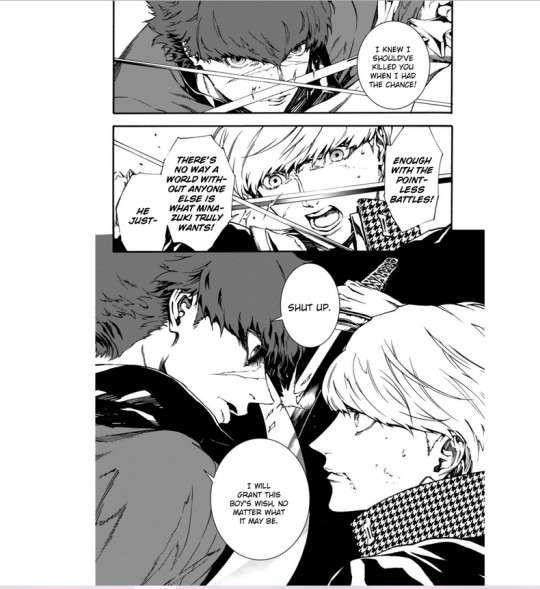
• I wish that translators would interpret Minazuki's use of “黙れ(damare)” as “Silence.” rather than “Shut up.” It fits his pre-established (by Ultimax-the-game) lexicon far more, in my opinion.
(Jap version of the page [here], because I forgot to take a picture of it, apparently. :P)

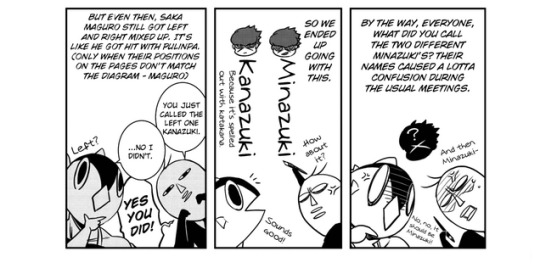

• Kanazuki, my beloved nickname. (Though, because pursuing lore details, I'm not sure if Udon's “the two sides of Minazuki” is an accurate translation in this case? It seems to be more like “the two Minazukis”, like how fan-Eng interpreted it, but I don't know enough Jap to tell. For those who want the transcript: ところで2人の皆月のことみんななんて呼んでる?皆月?ミナヅキ?文面ならまだしも打ち合わせの時彼らは大変混乱を招いてくれやがりましてね......)

• It's nice to have the uncropped version of the original Yu cover art... But I'm a bit sad that we don't get the original Sho/Minazuki back-cover as a poster as well.
• Interesting detail: despite reprinting and reformatting the title logos, they seem to have kept the signature color for each volume the same (Vol.1/yellow, Vol.2/red, Vol.3/pink, Vol.4/blue).
• I've already stated some of my thoughts on Ch.28 and Ch.30 here, but for a few things that I didn't cover...
1) Minazuki specifically thinking “The humans are shouting.” gives us an interesting window into his mindset at the time.
2) The doctors were shouting at him because he was climbing up into an open window more-so than just shouting at him in general, lol.
3) The Ikutsuki death report reads more as if Minazuki was narrating it rather than it just being Sho staring at information on a screen, which I think is a neat interpretation.
4) Sho might've been attempting to finish the 'Minazuki extraction procedure' that Ikutsuki began, rather than just blindly attacking Minazuki? I'm not entirely sure, but it's an interesting angle to consider nonetheless.
5) Ikutsuki spinning Minazuki as an “evil spirit” as another generally useful tidbit to employ in Sho characterizations.
6) “Murder pit”. I'm keeping this for my Minazuki characterizations going forwards, lmao.
• Generally adoring the larger page size, 'cause I can see more details in the art that also help me understand the context better in a lot of scenes. For example! After Tsukiyomi takes the full-power hit from Izanagi, I can see the clear signs of exhaustion and Minazuki pushing his limits in the continuation of the fight. His movements are more desperate, he gets pronounced bags under his eyes, he has a kind of wide-eyed look to him, etc. Which I think is a really nice detail, because it shows that Minazuki isn't invulnerable: his desperation to protect Sho is just that strong.
The dialog at the beginning of that scene also helps to demonstrate that: rather than continuing to think in fluent and complex words, his internal monologue is reduced to simple, fragmented instincts (“Can't falter... Must protect... Must...!"). Which, again, a very interesting window into how Minazuki thinks. Even when put under the physical strain of grievous injuries, his first instincts (in this situation, at least) are to hold his ground in order to protect Sho.
(...Though, the Jap text of the aforementioned dialog is a bit different than Udon's translation, lol. It's more like “If I... don't protect... I—" (俺が......守らなければ...俺が――...))
• I don't have much to say about the fight against Kagutsuchi due to not having the best focus when I read through that part of the manga. Hopefully one day I'll reread it with better success. ^^;



• Suicidal Sho? I'm not entirely sure, though, as the “思ってた” in the Japanese version of the text (死んじまうかと思ってた時...) seems like it could mean either “I believe (that this will happen)” or “I plan (on making this happen)”? I don't know what linguistic contexts lend to what definitions, unfortunately, and the visual context could support it either way. (Not to mention, I have no clue if the sentiment is being expressed in a literal or frivolous capacity, given Sho can be hyperbolic at times. >_>)
...Also, I'm not counting Sho knifing his own face as an intentionally suicidal action, because (to the best of my ability to understand) that was intended to be homicidal. It's just that it would have also had a suicidal effect on him.

• Shadow puppet-Yosuke, Shadow puppet-Narukami, and Yosuke are great, lmao.

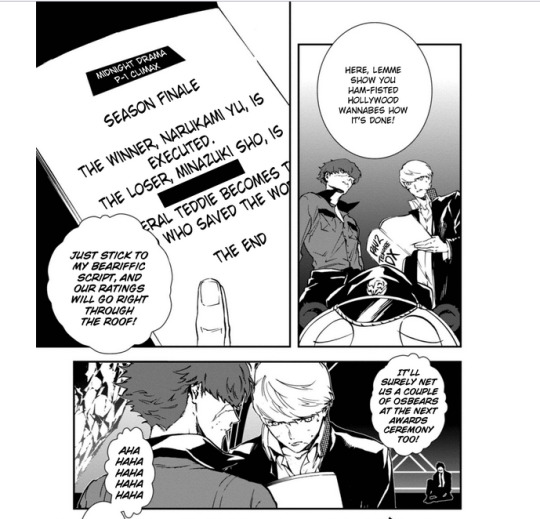
• Translations of General Teddie's script.

• Lastly, and maybe bestly: They got!! It right!! They kept Sho's name in Minazuki's “What are you going to do to Sho, Kagutsuchi?” line!! (Context: a previous observations/musings post of mine [here].)
-----------------------------------
(If you wanna see the fan-Eng in higher quality than the screengrabs I used, you can find it on Mangadex [here].)
#Sho Minazuki#Yu Narukami#Labrys#(tagging Labrys for the cover art)#P4AU/P4U2 manga#Persona 4 Arena Ultimax#P4AU#P4U2#Persona 4 The Ultimax Ultra Suplex Hold#ペルソナ4 ジ・アルティマックス ウルトラス―プレックスホールド
10 notes
·
View notes
Text
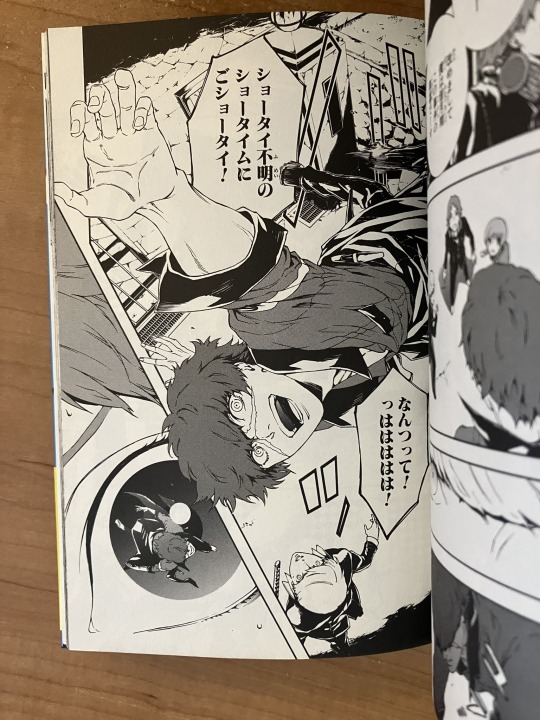


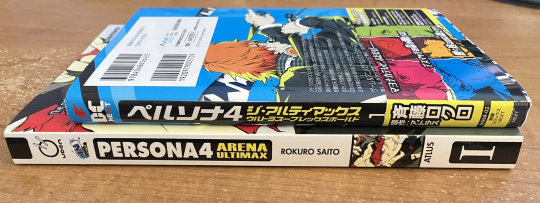
I'm a bit late to the party, but I recently got the first volume of the English P4U2 manga!
I am absolutely geeking out over comparing the Jap, Eng, and fan-Eng versions, so if anyone has any pages or panels they want to see side-by-side across the three, let me know and I'll make a post for you! I can't do the entirety of the book of course, but I can do a few pages at least.
--------------------
(Below the cut is my initial opinion on the quality of the translation work, some comparisons between various details of the Jap volume and the Eng volume, and some more manga page side-by-sides.)
--------------------
As for my impression of the translation work so far... To me, it feels like the translator was trying to preserve more of the original Japanese language/culture than Eng-P4AU chose to? Not in every instance though, as there's definitely cases where vernacular translations are utilized instead of literal. But where more literal translations are favored, the wording can feel a little awkward or OOC in English.
Even still, it's a pretty cohesive reading experience, in my opinion.
Also, they translated "Plume of Dusk" correctly, which is a relief. I was worried that some of the technical lore terms might get bungled by literal translations, lol. Conversely, while I'm glad that they didn't preserve Jap-Teddie's "-kuma" habit, and happy that they included a few bear puns in accordance to Eng-Teddie's speech habits, I do lament the low quantity and diversity of bear puns in Teddie's speech overall. Maybe there just wasn't a lot of good places for those in this volume though, so I'll have to see going forth.
Oh- and I noticed that some of the background signs and text got translations as well, which I think is really neat. (I don't read enough manga to know if that's just a standard feature of manga translations though, lol.)
Granted, this is just my first-read first impression, and I don't know enough Japanese to know if some lines may be translated less accurately or not. Plus, I tend to be on the lenient side when judging the quality of creative works. So please refer to other opinions as well if you're trying to decide the quality of the translation for yourself!
--------------------
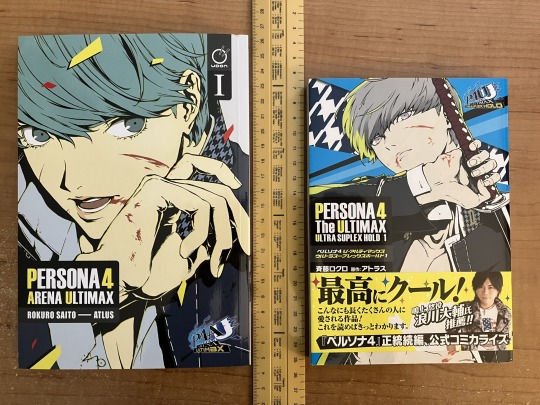
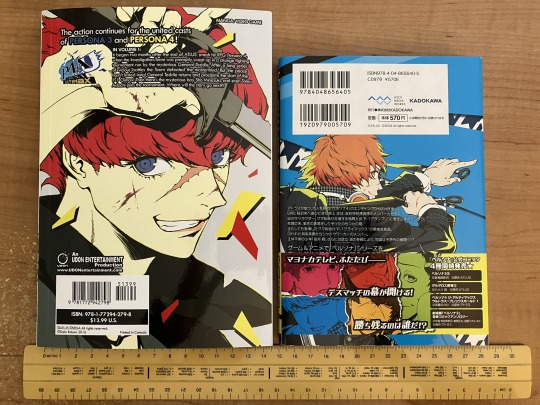
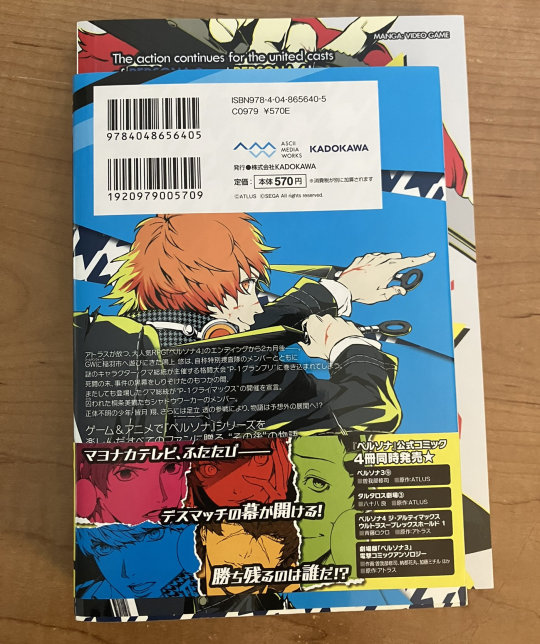
Fun fact: the Eng version was printed bigger than the Jap version (at least for the Jap volumes I have; no clue if they printed those at multiple sizes).
--------------------
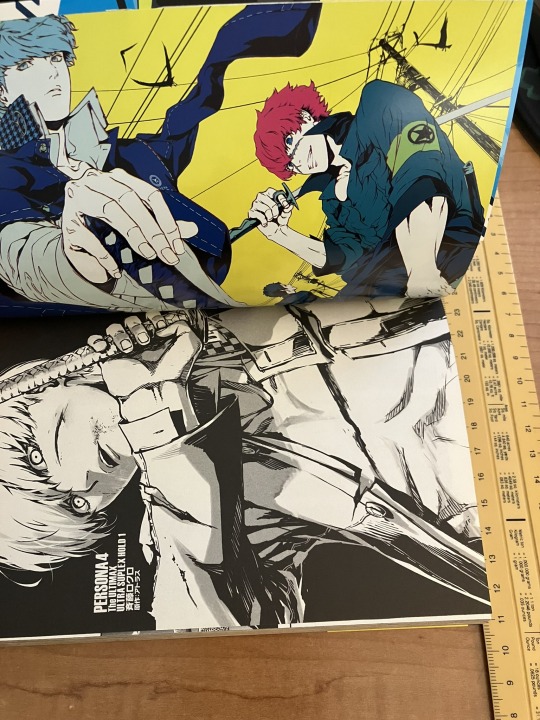
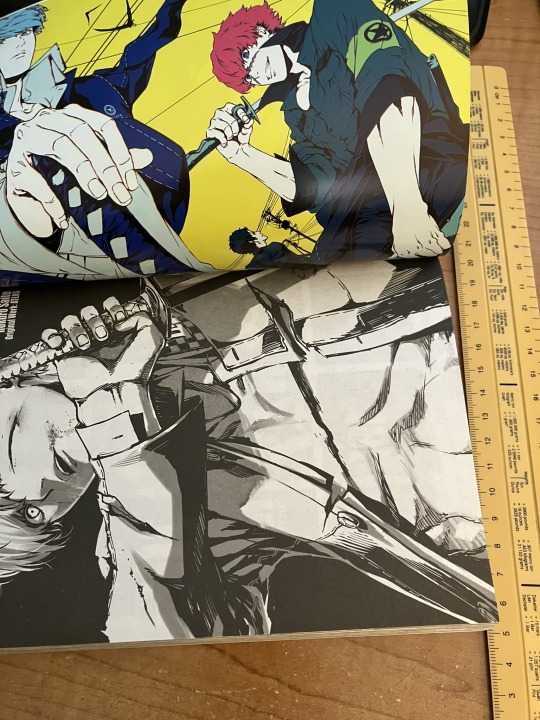

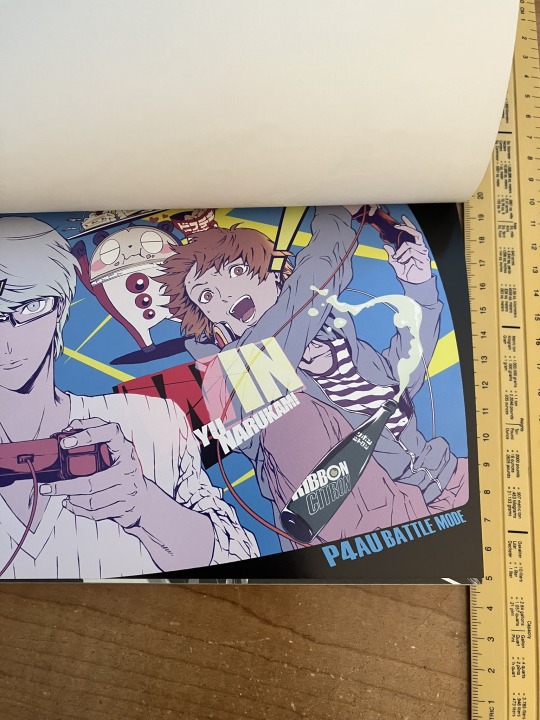
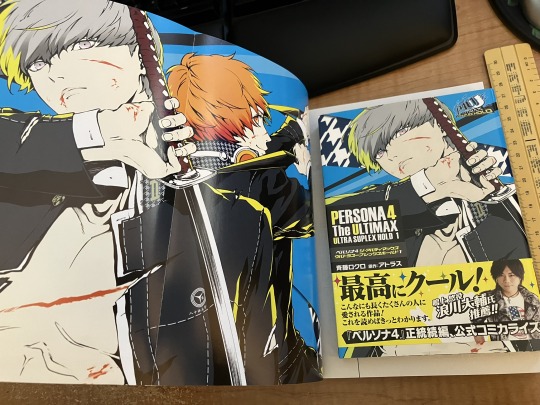
Also something cool about the Eng version is that it comes with the same color illustrations as the Jap version had, just sized-up. The exclusive edition also comes with a bonus fold-out poster of the original volume cover!
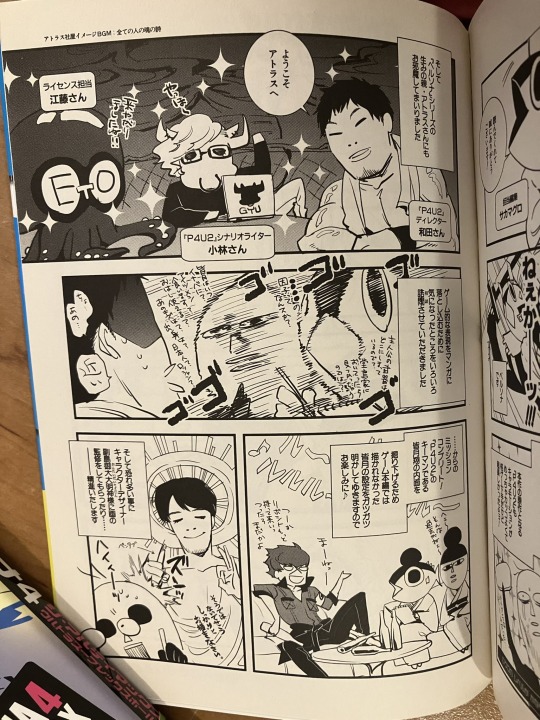
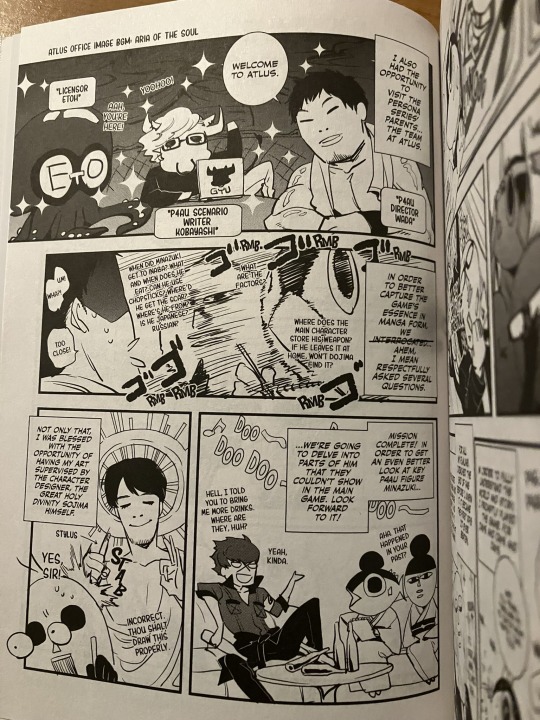
The end-of-volume artist/editor comic was included as well! I'm personally very glad to finally know what this comic says. My respect for Rokuro-san and Sakamaguro-san (the fish) as creatives has grown even further.
--------------------
Here's a few other page comparisons too because I found them interesting. xP

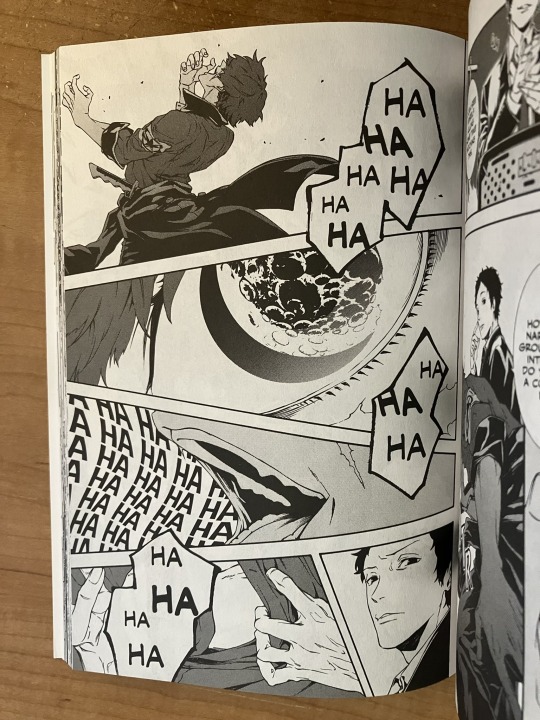

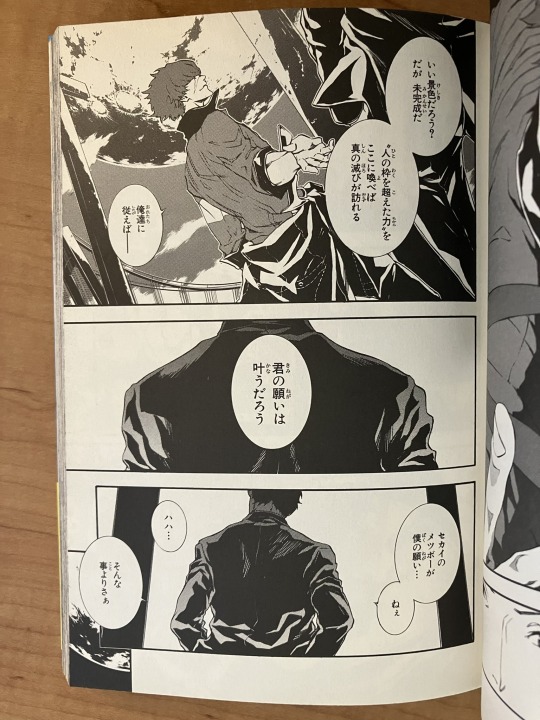
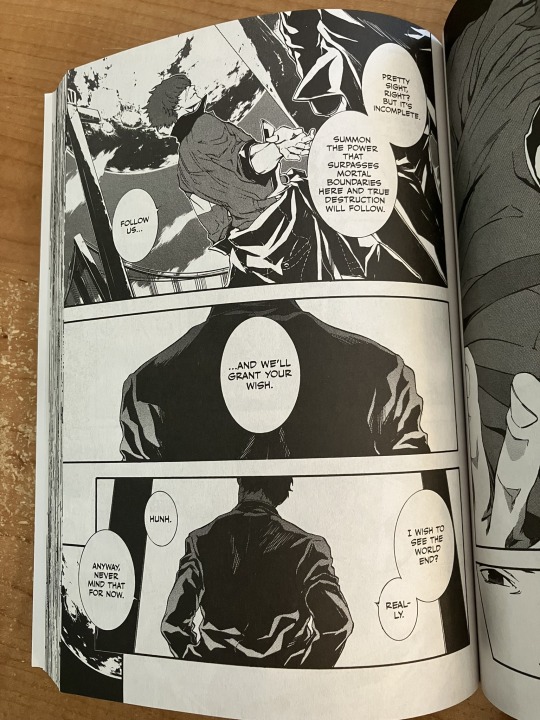
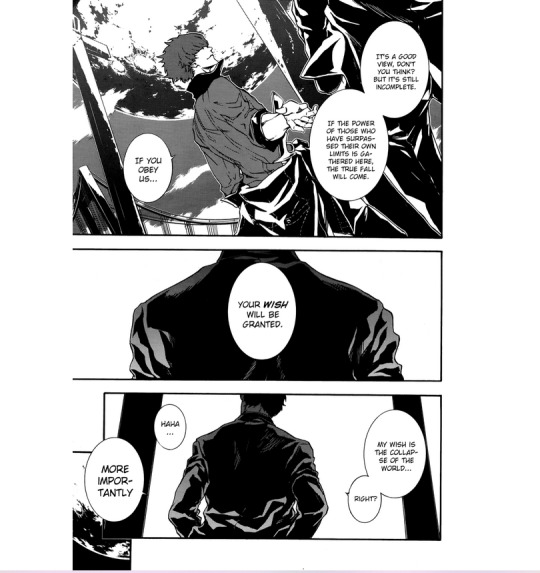
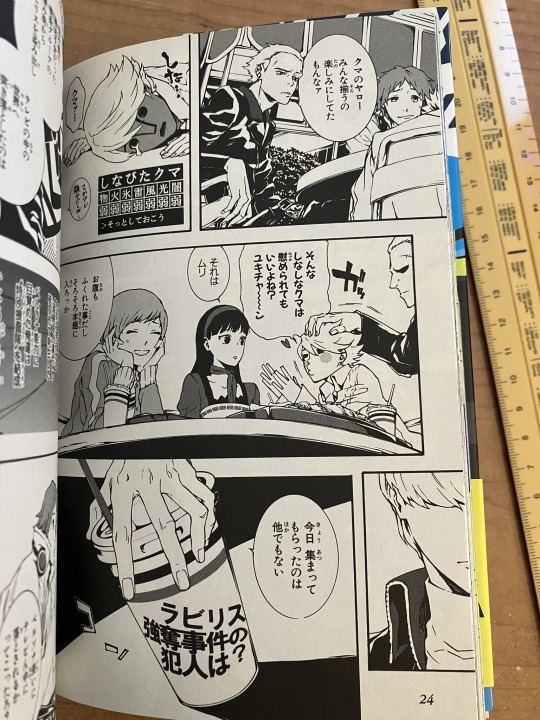

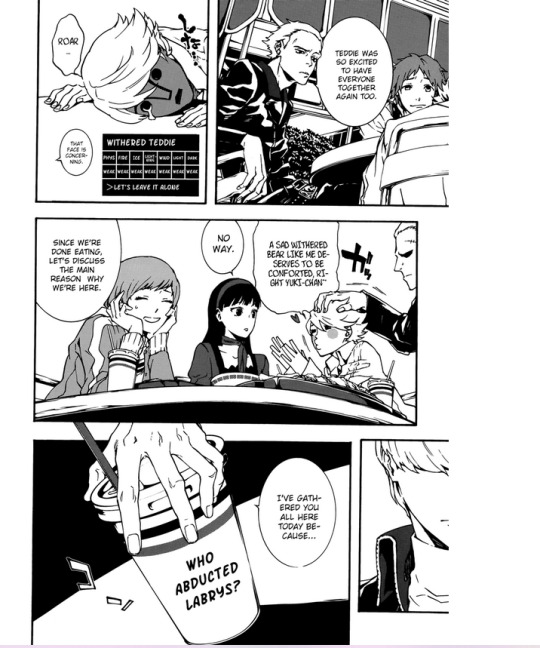



(If you wanna see the fan-Eng in higher quality than the screengrabs I used, you can find it on Mangadex [here].)
#P4AU/P4U2 manga#Persona 4 Arena Ultimax#Sho Minazuki#Yu Narukami#(Honestly I kinda got used to reading slightly-OOC Persona content via fan creations -)#(- and fan-translations of other Jap Persona content; so the translation choices don't affect me all that much lol)#(Though Sho's “loser trash” makes me cackle because it's such an awkward way to translate “ゴミ”)#(Especially "Now to set up some fun surprises for you Investi-loser trash-Team goons.” lmao)#(Also still waiting to see how Labrys's dialect is handled; as well as the 皆月・ミナヅキ name difference)#(I've heard things about both already so that's going to be interesting lol)#P4AU#P4U2#Persona 4 The Ultimax Ultra Suplex Hold#ペルソナ4 ジ・アルティマックス ウルトラス―プレックスホールド
15 notes
·
View notes
Text
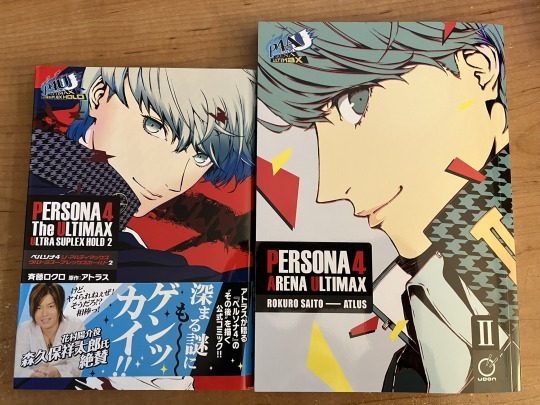
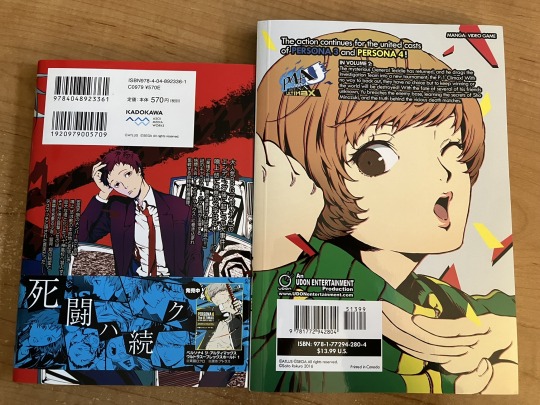


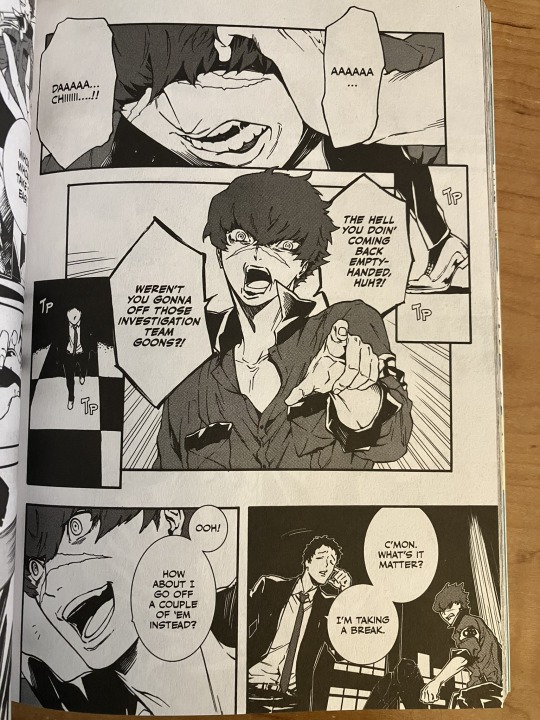
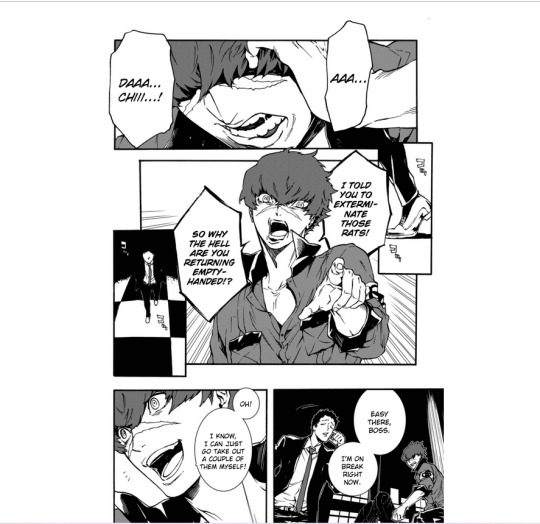
Time for English P4AU manga volume 2! Like last time, shenanigans are below the cut and requests for page comparisons are always welcome.
~~~~~~~~~~~~~~~~~~~~~~~~~~~~~~~~~~~~~~~~~~~~~~~~~~~~~~~~~~~~~~~
Overall Opinion
My initial read-through this time was done while I was sleep deprived, so take my impressions with a grain of salt, lmao.
I think the the three most memorable impressions I took away from the translation this time around were:
The syntax felt more markedly stilted to me than last time. As well, the writing was a bit awkward in some places, though I'm unsure if that's a trait of the original Jap writing or if it only arises from attempting to format it into Eng grammar and culture.
The fan-Eng translation took creative liberties with some words that I think were better served by the official-Eng's translation staying truer to the Jap text. Also, the official-Eng transl provided interesting insight into some things that the fan-Eng transl didn't, which I'll go into a bit below.
The scene where Minazuki ambushes Naoto was mistranslated as Sho being the speaker, despite the Japanese text clearly being Minazuki's language patterns. TuT
Overall, I had a positive impression of it and would say that it's worth reading for those who don't mind a few errors and awkward lingual choices.
As for the ミナヅキ・皆月 naming differentiation... Thus far, both Sho and Minazuki have been "Minazuki", as per adherence to the Jap naming scheme. No alternative font, font effects, subtext, special text bubbles, nor anything to clarify the distinction. However, I'm personally reserving judgment until I get my hands on Vol 3, as I have a sliver of hope that the protagonists knowing the difference is permission for the audience to know the difference. I'm not sure how much I actually believe in said sliver, but I'm willing to give the benefit of the doubt at the very least. ^^;
~~~~~~~~~~~~~~~~~~~~~~~~~~~~~~~~~~~~~~~~~~~~~~~~~~~~~~~~~~~~~~~
Illustrations and Author Comics
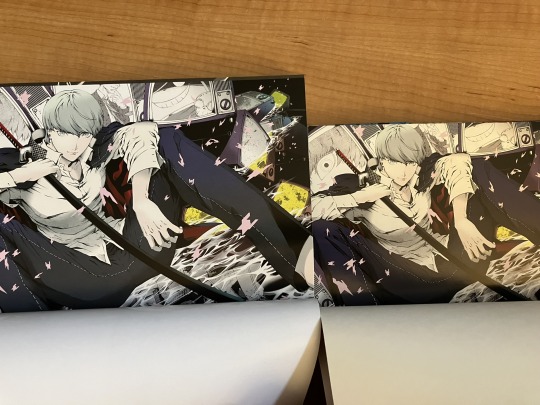
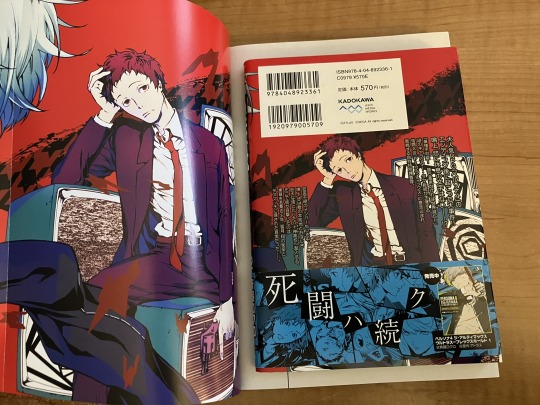
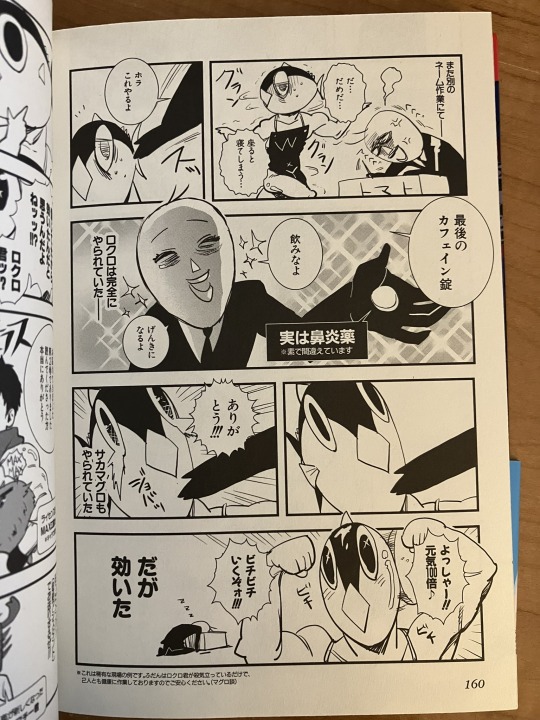
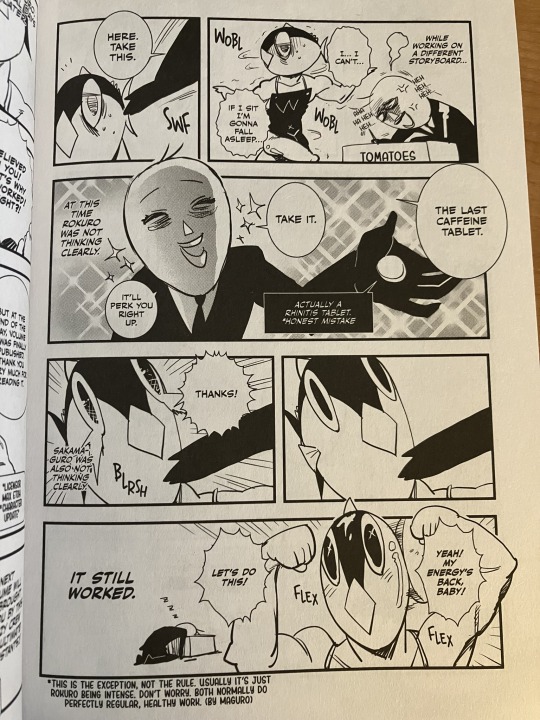
Vol 2 still has the illustration pages and end-of-volume author's comic! The exclusive edition also has the fold-out poster of the original cover, of course.
~~~~~~~~~~~~~~~~~~~~~~~~~~~~~~~~~~~~~~~~~~~~~~~~~~~~~~~~~~~~~~~
The mistranslated ambush scene was, in fact, Minazuki


So y'all can see for yourself that the text in the Minazuki-Naoto ambush scene clearly uses 俺 and 君 rather than 僕 or テメエ. (Though to be fair, I've actually found an instance where Sho uses 俺 in Vol 2. The line is 「テメエこそ俺にカンショーすんじゃねえ!!」, towards the start of Ch14 when Kagu's mocking his Ikutsuki issues (so Sho's pretty irate). He then returns to using 僕 immediately after; and as there are no visual indications that he switched with Minazuki to say this, I'm pretty confident that this is an exception and not the rule, lol.)
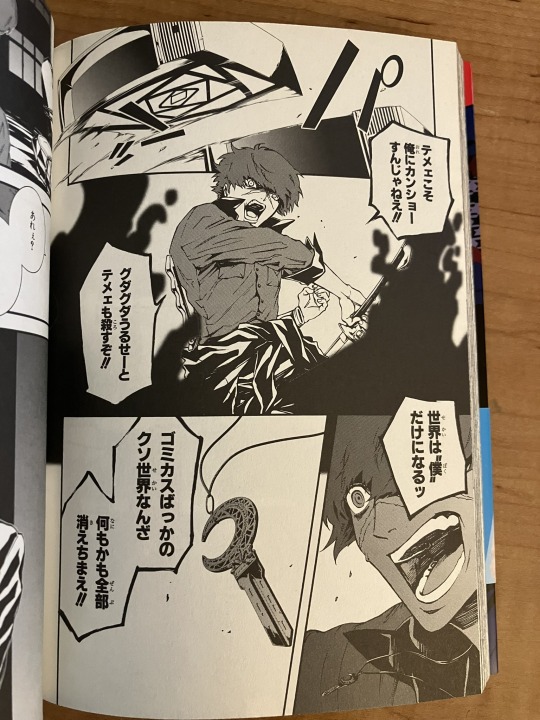

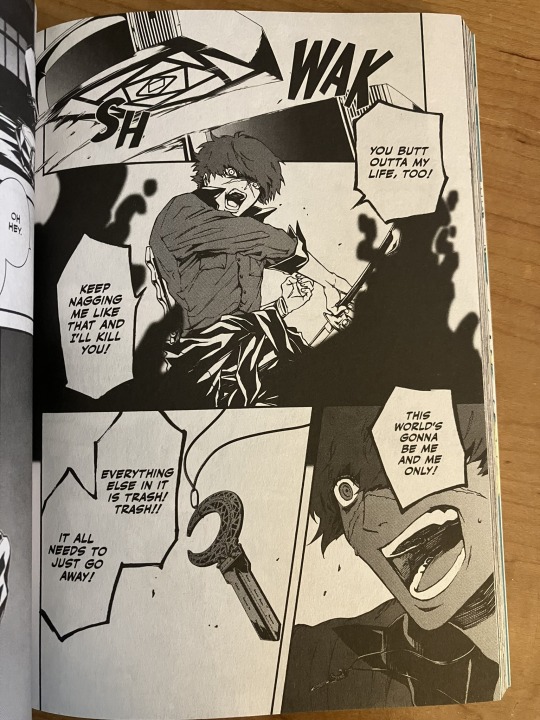
(Said instance of Sho using 俺)
The non-pronoun words should be indicative of whether it's Sho or Minazuki speaking as well, but I'm not fluent enough in Japanese to be able to go into detail on those in this post. ^^;
Overall, I think the translator has been doing pretty good at nailing Sho and Minazuki's respective patterns of speech and employing them in the correct moments – and they go back to getting it correct for when Minazuki reveals himself at the end of Vol 2, too. This one scene just got goofed for some reason I guess. P:
~~~~~~~~~~~~~~~~~~~~~~~~~~~~~~~~~~~~~~~~~~~~~~~~~~~~~~~~~~~~~~~
Translation Upsides
Translation Win 1: Ch15's name was translated properly! The Jap name is 「幻月」 (gengetsu), but the fan-Eng translated it as "Minazuki", which would be 「皆月」 if it was in kanji form. Which – I mean, it is the chapter that Minazuki first formally introduces himself as "Minazuki", so it makes sense? But I personally think that "Paraselene", aka the phenomenon called "moon dogs", is a much cooler and more fitting name for how the chapter goes, including Minazuki's reveal. (-v-)
Translation Win 2: At the start of Ch14, Sho says "Tch! Must've fallen asleep. Hate that dream.", which implies that he's had that dream before. I don't know enough Japanese to know if the original line of 「チッ 寝ちまったのか... 嫌な夢だぜ」 also means a recurrence specifically, but it's still interesting fanon-characterization fodder nonetheless.
Puppet-Ikutsuki's following dialog was also a pretty interesting translation, I think. For example: "The smarts to rule the mental battle. The strength to command the physical battle..! You excel in both! In fact, I'd say you're my greatest masterpiece! I'm proud!"
Translation Win 3: In Ch13, Kagutsuchi's first line of reaching out to Sho is translated correctly as "wings of death", versus the "Plume of Dusk" that the fan-Eng transl uses. Conceptually, they're probably the same thing, but literally the word used is 「死の羽根」 (shi no hane), not 「黄昏の羽根」 (tasogare no hane; which is typically "Plume of Dusk" in Japanese). And this isn't a mistake on the part of the Jap writer either, as far as I can tell, as 「黄昏の羽根」 is used in other places, such as when Labrys is explaining what Plumes are to the Investigation Team ([see here]).
Additionally, though the syntax was exceptionally awkward, I thought the essence of Kagu's dialog in this scene was translated pretty well. And honestly, it's fun to headcanon that Kagu could only communicate limited concepts or words before establishing a stronger connection, thus explaining why the syntax is stilted like: "Your suffering will continue. Eternally. End it."
Translation Win 4: It's a small detail, but Ikutsuki specifically saying "If this is all it takes to kill him... Then that's just how weak he was." is heckin' brutal. Switching to past-tense like Sho's already done and over with when he's still alive and listening, oof. (For comparison, the fan-Eng translated it as "If he dies here, it'll just mean he's worthless.")
~~~~~~~~~~~~~~~~~~~~~~~~~~~~~~~~~~~~~~~~~~~~~~~~~~~~~~~~~~~~~~~
Translation Downsides
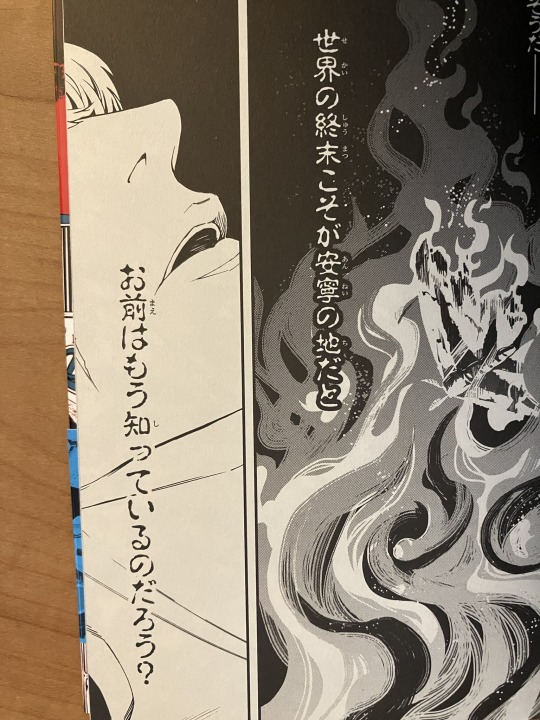

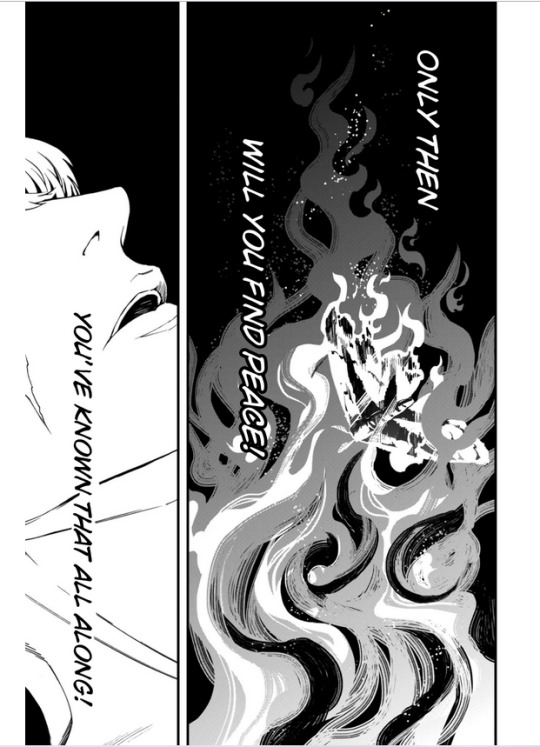
Typography Loss 1: Kagutsuchi's text still lacks a cool font like the Jap version has, and that reduces the artistic impact a bit, IMO. In the Jap version, it looks a bit like the text was scorched onto the writing surface – which, given Kagu is a kami of fire, is a pretty apt vibe. While in Eng, he's relegated to the font that all the other characters use while speaking. It's probably better like this for readability purposes, but from a stylistic perspective it's a bit sad.
(Also fun fact: In Jap, the Shadow-Kanji and Shadow-Chie puppets briefly use this burnt font in their speech bubbles. It's for about 1-2 bubbles each (S-Kanji calling forth a fighting ring, S-Chie being in disbelief that Naoto had been holding back against her), and the rest of their dialog is in various other fonts. I'm not sure if there are other instances of non-Kagu characters using it beyond that, nor what exactly it's intended to imply through these additional instances, but it's interesting to note.)
(Additionally; examining it more closely, the Japanese typography is really dynamic in general, which is pretty cool. I'm not sure if that dynamicness invalidates any literary significance to Kagu's burnt font though, lol.)
~~~~~~~~~~~~~~~~~~~~~~~~~~~~~~~~~~~~~~~~~~~~~~~~~~~~~~~~~~~~~~~
Translation Intrigues and Amusements
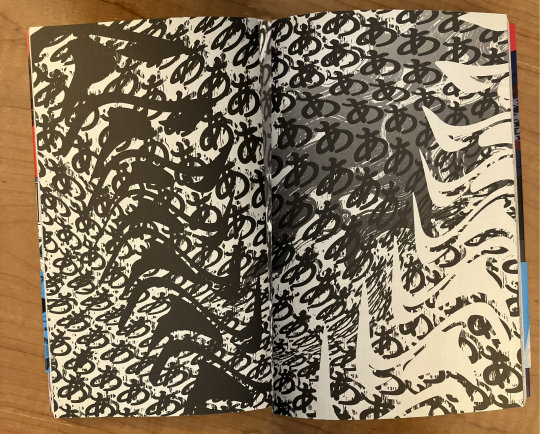
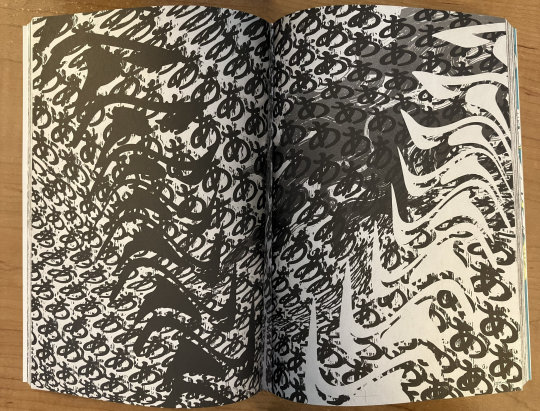
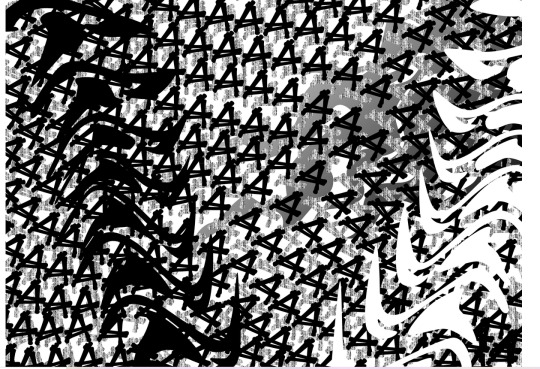
Typography Intrigue 1: They left the page of fiery "AAAAAAAAAAAAAAAAAAAA"s as-is, rather than trying to turn the 「あ」 and 「ア」 into "a/A". Which, while I immensely respect the fan-Eng version for trying to transcribe that artistic text, I think the horrific vibe comes through a bit better with the original text and art preserved. (Maybe in part due to the wave effect on the text having 3 dimensions rather than just 2?)
Translation Intrigue 2: In Ch13, one of the double page spreads is translated as "This world doesn't need anyone. There's no one in this world." Meanwhile, in the fan-Eng version, it's written as "I don't need anyone! I'm fine by myself!"; and the original Jap text is 「この世界には誰もいらない この世界には誰もいない」 (the same line, just minus the ら).
I personally prefer the fan-Eng's take on it, as the official-Eng's version confused me for several weeks after the fact; but as I don't understand the nuance of the Jap version, I have no clue as to which Eng interpretation is more accurate. >_>;
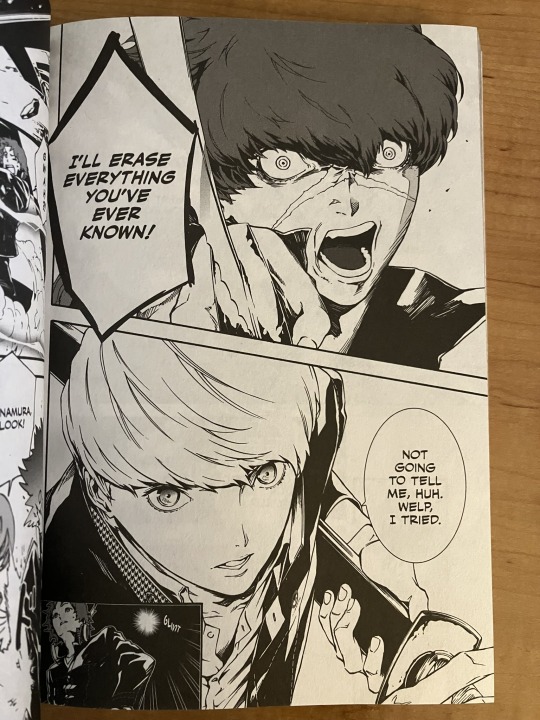
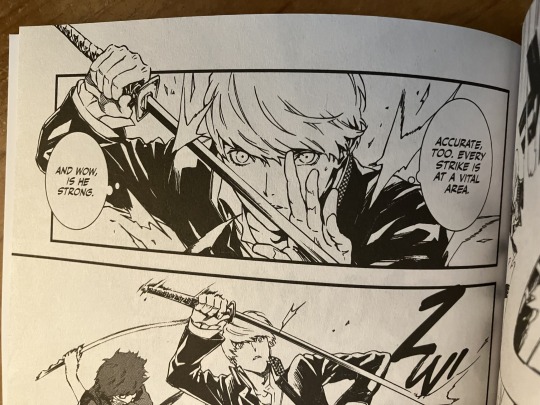
Translation Amusement 3: Yu apparently has the word "welp" in his lexicon. And on the second page, the way that his dialog is worded makes it sound like he's smitten with Sho, lmao.
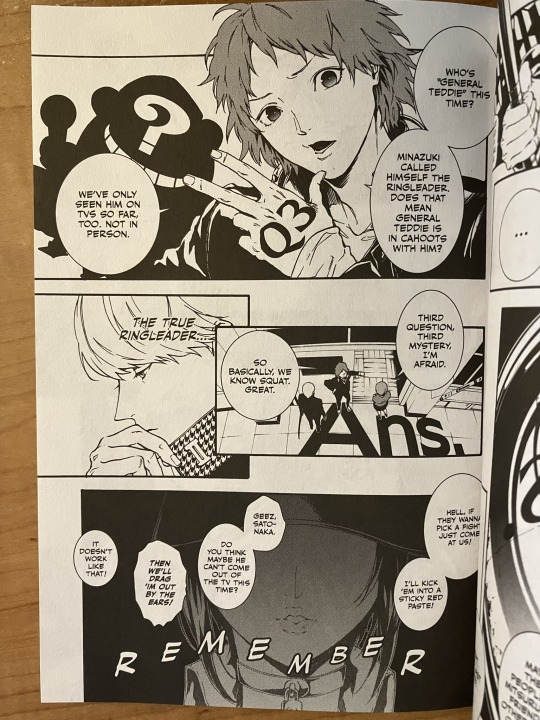
Translation Amusement 4: Yu's so used to his friends' antics at this point that he can just tune them out like that, lol. I also just appreciate Chie and Yosuke's dialog here in general.
Translation Intrigue 5: Ch13's title is translated as "Crimson Memories" in the official-Eng transl, versus fan-Eng's "Scarlet Memories". The original Japanese words are 「緋色の記憶」.
Translation Intrigue 6: What's typically translated as "the rules of this world" (regarding Adachi) is translated here as "reality's rules". The original Jap text (in this manga at least) is 「現実のルール」, not 「世界のルール」; so literally "reality", like "reality of the situation", and not 'reality' like "world/society".
Translation Intrigue 7: Ikutsuki's iconic "the death of everything... but also the beginning" speech is translated a bit differently compared to the fan-Eng, and drastically different compared to Ultimax's EpP3 Ch1. It keeps the same general concepts, but the cadence, word choices, and syntax are executed differently.

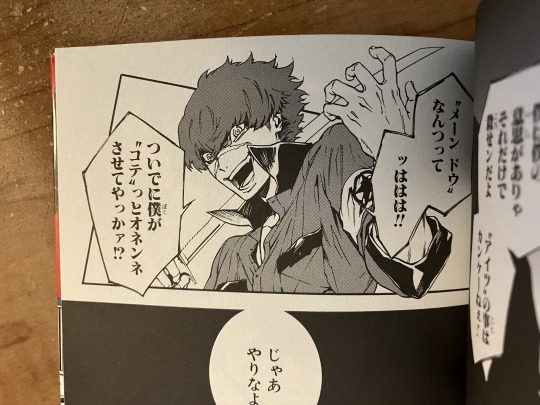
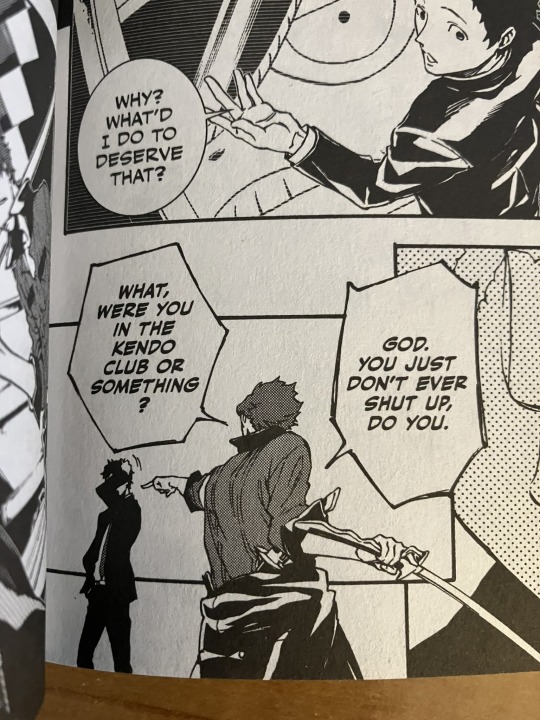

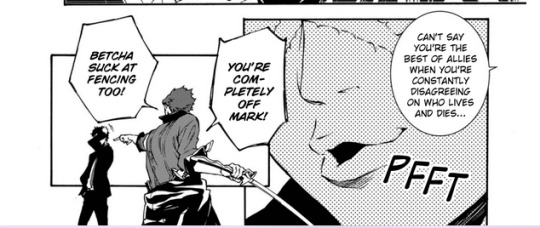
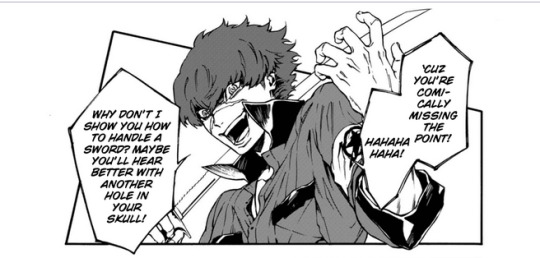
Translation Intrigue 8: Side-by-sides of the kendo/fencing pun because I think the differing translation choices, as well as the original context of the pun, are interesting.
~~~~~~~~~~~~~~~~~~~~~~~~~~~~~~~~~~~~~~~~~~~~~~~~~~~~~~~~~~~~~~~
(If you wanna see the fan-Eng in higher quality than the screengrabs I used, you can find it on Mangadex [here].)
#Sho Minazuki#Yu Narukami#Chie Satonaka#(tagging Chie mostly because of the cover art; in case any fans of hers want to see it)#Shuji Ikutsuki#HinoKagutsuchi (Persona)#P4AU/P4U2 manga#Persona 4 Arena Ultimax#P4AU#P4U2#Persona 4 The Ultimax Ultra Suplex Hold#ペルソナ4 ジ・アルティマックス ウルトラス―プレックスホールド
10 notes
·
View notes
Text
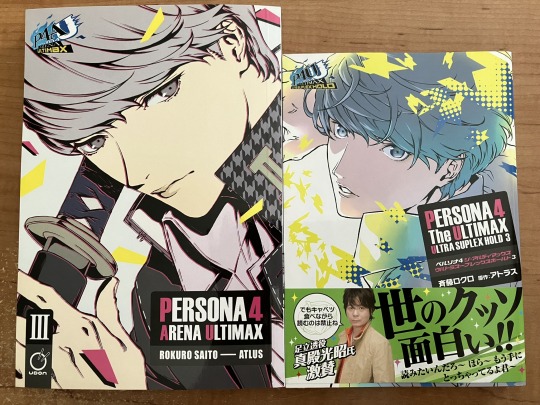


Ultimax English Volume 3, coming hot at'cha from me, who did the read-y thing!
Gonna repeat it for the folks who might be landing here for the first time: I've written up my initial impressions and observations below the cut, as well as sprinkled in some pictures comparing the three versions of the manga (OG-Jap, official-Eng translation, and fan-Eng translation). And if you don't see something there that you'd like to know more about, you can always hit me up with requests and I'll see what I can do for ya!
Oh– and of course, spoilers are no holds barred. So if you want to read the manga blind, then this is not the review post for you. Nor are my other ones.
So without further ado... The post!
~~~~~~~~~~~~~~~~~~~~~~~~~~~~~~~~~~~~~~~~~~~~~~~~~~~~~~~~~~~~~~~
Main Opinions (5)
~~~~~~~~~~~~~~~~~~~~~~~~~~~~~~~~~~~~~~~~~~~~~~~~~~~~~~~~~~~~~~~
[1]
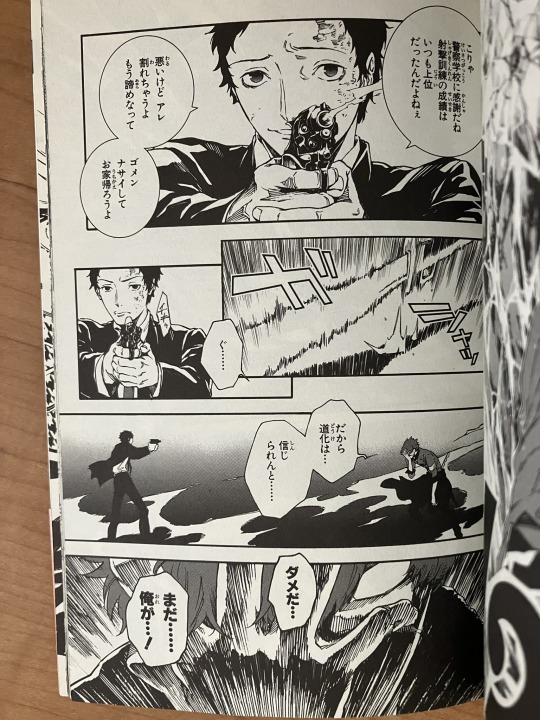
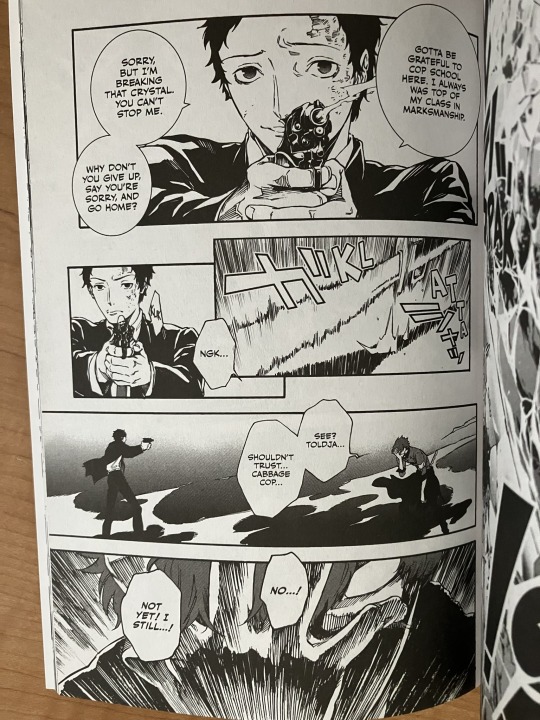

Like the volumes before it, I continue to both agree and disagree with the various translation choices. Using the page above as an example: I think that translating 道化 as “cabbage cop” rather than the literal meaning of “jester/clown”, especially after using the latter translation before in Vol 1, wasn't the best choice. On the flipside, I think that choosing to retain the presence of the “俺が...!” by including “I still...!” in the translation was a good call, because the specific ways that characters speak are a quintessential window into who they are as people.
(Re: "cabbage cop"; the translation also just suddenly spikes in referring to Adachi as “cabbage” in the aforementioned chapter and the one immediately following it, lol. Sho says “I wanted to help even a loser like you have a good time... So I went outta my way... to keep your lame... cabbage ass alive...”, though nothing in the Jap text even makes mention of “cabbage”, much less Adachi's ring title.)
[2]
Though I don't think I mentioned it in my previous posts, I also retain my opinion that the onomatopoeia in this translation is on point. Much like the original Japanese version, the chosen sounds make sense for the actions they're supposed to be accompanying. And this has been consistent throughout all volumes, rather than having ups and downs of quality... at least from what I can recall.
[3]
However, in reading this volume, I have come across my first genuine critique of the translation: in all the volumes thus far, quotation marks that should be carried over from the Japanese text are often ignored, to the immense detriment of the English reading experience. Fortunately, this problem hasn't extended to text emphasis (e.g. bolded text and bōten) or the rest of the punctuation, as they have been relatively good at preserving and employing those. But, to exemplify what the lack of quotations does to the text...
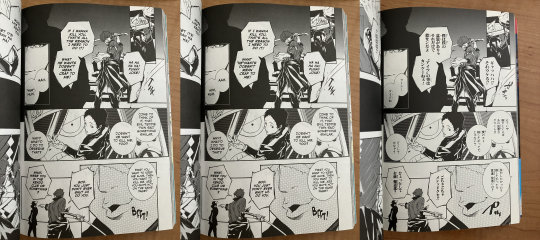


...just read through the side-by-side page examples I edited above. The difference should be apparent, hopefully. (Btw, edits are in the middle and on the bottom, respectively. Jap text is also included for quotation placement reference.)
The thing that baffles me about the lack of quotations, though, is that the translation does use them on rare occasion. For example, when Minazuki says “Welcome to 'his' world.”, and “Oh yes. You call those shackles 'bonds', don't you.”, those quotations exist in the Japanese text as 「“���”」 and 「”絆”」. But in the vast majority of cases, even sometimes when the usage in Japanese is back-to-back, they're just kinda... glossed over? I really don't get it. ^^;
[4]
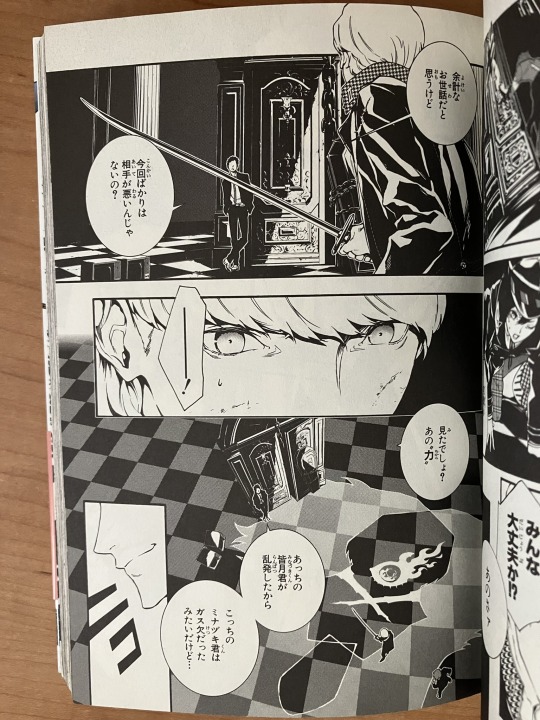

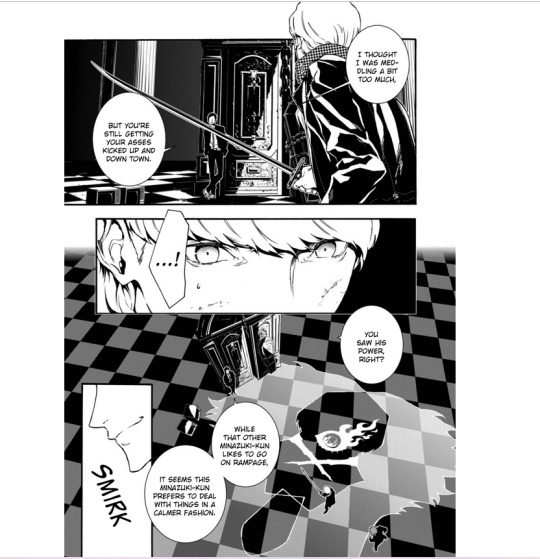
Moving on to a semi-related topic... The 皆月・ミナヅキ naming differentiation... uh... yeah. That's a weird thing. The simple part is that both are continuously referred to as “Minazuki”. The weird part is that the translation seems to want to refer to them as a "single but plural" entity? For example;
“I sat back and let Minazuki do their thing and they just wasted time forever.”
“There's much to sympathize with in their past. And they're clearly a victim of the Kirijo Group's darker side.”
"But we're gonna get back at that jerk. Both of 'im!".
"We can't let Minazuki get what they want! Stop 'em, Narukami!"
Which, in all fairness, the Japanese version is partially responsible for. Since [plural nouns are implied more than said outright in Japanese], and there are some occasions of 「皆月達」 (Minazuki-tachi; look under "Plural Suffixes" in the linked article) interspersed within the writing, I can understand how the "single but plural entity" translation came about. I'm not knowledgeable enough to know if interpreting just "皆月" as plural is always correct or not, but I can see why it might be tricky to interpret, at the very least.
So personally, my gripe with it is just the lack of distinction between instances of ミナヅキ and 皆月, as when which one is used is extremely important for story context. The characters awkwardly referring to Sho and Minazuki as singular but plural (in a purely-Eng reading) seems logical enough, since none of them have experience with plurality up until this point, and it's not like they're getting the opportunity to ask the system in question what form of address they prefer.
[5]
Oh, and while we're within the topic of “things that could be better off if a guide of important pre-established terms was implemented”...

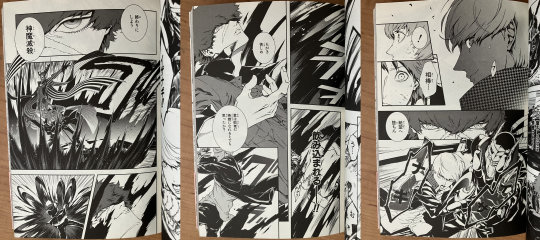
Y'all might think “holy heck, why did they turn Minazuki's edge factor up to 11 here?” with a slow cringe of disturbance or disgust. (Or maybe the laughter of vicious mockery. What do I know? Lol.) I concur! So I did what I do when I'm confounded by something: question everything about it. In doing so, I thought to myself; 'Hey, isn't that "hero" one one of Minazuki's VLs from Ultimax?' The answer was yes, it was, although it goes slightly differently. And what had the manga done back in previous volumes? Quote combat-VLs from the game during battle scenes.
So after transcribing the Japanese text of the lines in question into Jisho and Google Translate, as well as listening to the Jap versions of the EngVLs that I thought were similar enough, this is what I got:
“Writhe in pain!” = “Struggle. Suffer.” (「もがき 苦しめ」, [VL nb315a])
“Did you think you could become a hero?” = “Did you think you were some kind of hero? No. You're just the loser.” (「(君は敗者だ)英雄になれるとでも思ったか?」, VL nb342b)
(Note: The “No. You're just the loser.(君は敗者だ)” portion isn't a part of the VL in Ultimax, and aside from Adachi's Winner's Interview line for defeating Minazuki, I couldn't find anything similar in any of Mina's non-Story Mode Eng VLs. (I didn't check their Jap equivalents, as I still need to compile those lines into a searchable resource. >_>) So unless it's somewhere in Story Mode, it may have been ad-libbed in by the author.
“Let despair swallow you.” is less cut-and-dry. The Japanese text is 「絶望へ堕ちろ」; but when I listened to similar VLs (nb313a: “It's time to despair.”, nb317a: “Fall into darkness!”, nb320a: “Descend into the abyss!”), I only ever got partial matches. Nb313a has 「絶望」, while nb320a might have 「堕ちろ」, but my auditory comprehension of Japanese still needs a lot of work, so I may be mistaken. And nb317a matched nothing, from what I can hear. So unless this comes from a story VL, or a VL that isn't translated closely enough for me to sleuth back to the Jap VL... then I guess this might also be ad-libbed or frankensteined by the author?
Also, I'm not sure if it's coincidence or if there actually was some knowledge of the pre-existing translations, but the translator got “God and Demon Annihilation” correct, lol.
So yeah. "Edginess"? Not really more than normal when you have the context; but as a standalone experience, a great deal more than normal and would have realllllllly benefited from referencing the pre-established translations. The translator can take stylistic liberties with the whole rest of the translation, so I really don't think that employing such a small list would compromise their freedom?
(And if you want to see how the fan-Eng version handled it for comparison...)
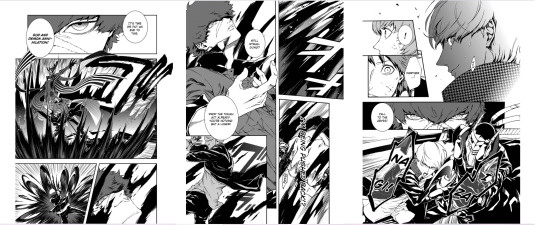
~~~~~~~~~~~~~~~~~~~~~~~~~~~~~~~~~~~~~~~~~~~~~~~~~~~~~~~~~~~~~~~
Additional Thoughts (6)
~~~~~~~~~~~~~~~~~~~~~~~~~~~~~~~~~~~~~~~~~~~~~~~~~~~~~~~~~~~~~~~
Alright, let's see, what else do I have left to cover...
[1]
Labrys doesn't talk a ton in this manga, so her “Southern, not Brooklyn/Boston accent” issue, while still there, isn't too glaring or easy to spot in a lot of lines. However... Honestly, I think it's just the translator's style overall to use a more 'Southern USA dialect' in their wording. Please note that I'm not an expert on this matter what-so-ever! But that's just the vibe I've been getting from how all of the characters have been speaking across the official-English volumes (and which isn't present in the fan-Eng translations).
[2]
I referenced the line briefly before, but the translation of Minazuki saying “...Yu Narukami. How about you throw away those shackles you cling to? They're dead weight to you. You can hardly fight, or even run, while you carry them. […] Oh yes. You call those shackles 'bonds', don't you.” in reference to Chie and Yosuke being incapacitated is brutal and I love it.
[3]
Before learning Kagutsuchi's name, Adachi calls Kagutsuchi "Mr. Crazy-Pants", lol. ("That's why you set up your whole little plan to use the power inside me to control that. And that means you've only been pretending to be best buds with Mr. Crazy-Pants.")
(Or in Japanese: つまり 君らは凶悪なクマ君に従っているフリをしていたってワケか || Though, I'm not sure if 'vicious Bear-kun' has a similar vibe to "Mr. Crazy Pants" in Japanese or not?) (Also fun note: Adachi's 「君ら」 (kimi-ra) is another pluralized address of Minazuki and Sho, so it's not always just their direct name getting that treatment.)
[4]
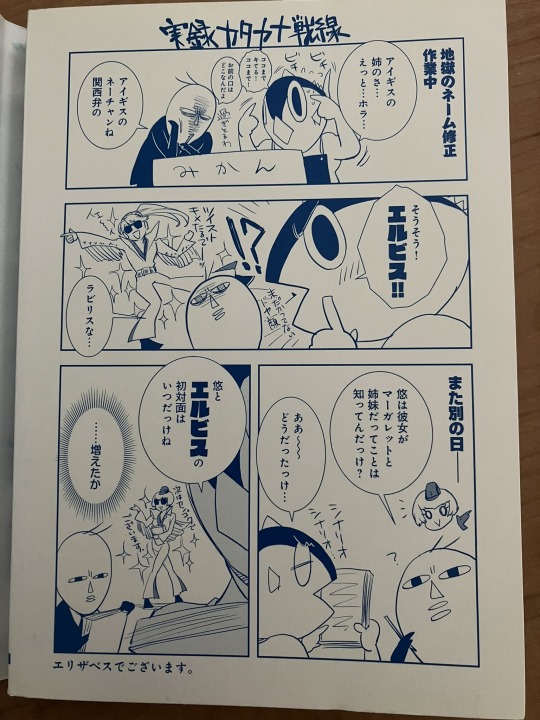
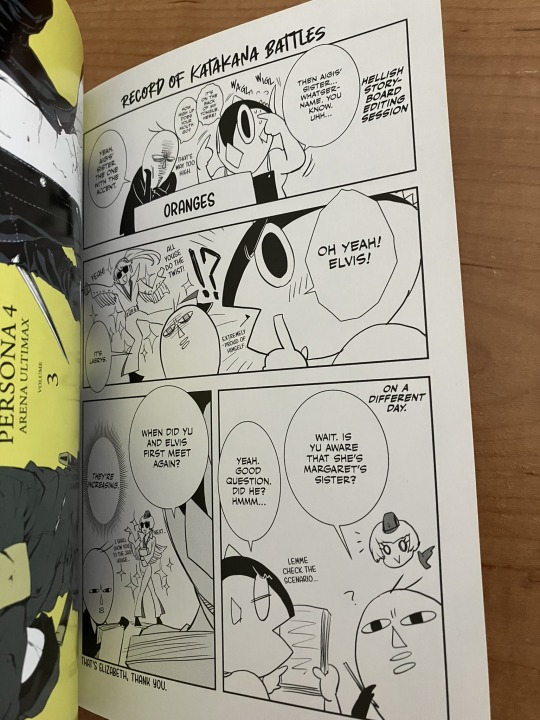
Labrys is secretly Elvis confirmed. Also, the author comics are to be found on the inside covers for the Eng translation, versus being on the outside covers (and obscured by the book jacket) in the original Jap print. This is something that only Vol 3 and Vol 4 do, as Vol 1 & 2 had enough space left to print the author comics on actual pages.
[5]
I think some of the gikun nuance might've been glossed over, but I honestly still don't know whether it's the subtitles or main words of gikun that are supposed to be "spoken" in-story. I only just found out the proper name for them while making this post, and the things I've read about them so far contradict each other, lol. Also, the official-Eng translation takes the third example below and translates it as both "Minazuki"(Sho) and "this child" at different points in Vol 3, which doesn't help my confusion, lmao.
(Checking out an instance of the first example as well, it gets translated from "ジュネスでミナヅキ[あの男]に襲われもしたが" to "That man. Minazuki? He attacked me at Junes...", occurring when Labrys and Naoto save Chie and Yosuke from Minazuki's attack in the faux-Tartarus lobby.)
E.g. "ミナヅキ [あの男]" ("Minazuki" subtitled with "that guy") - "皆月達 [あのコら]" ("Sho & Minazuki" subtitled with... my guess is "those kids", but the 'ko' is katakana and not kanji, soo...) - "皆月 [あの子]" ("Sho" subtitled with "that boy")
[6]
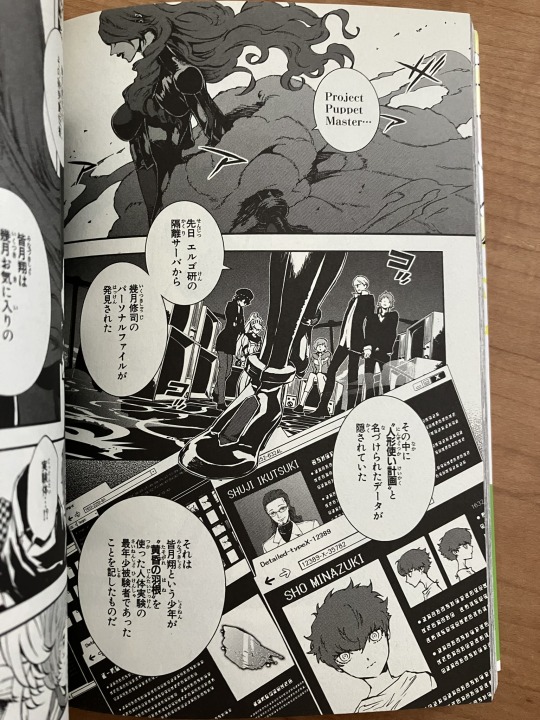
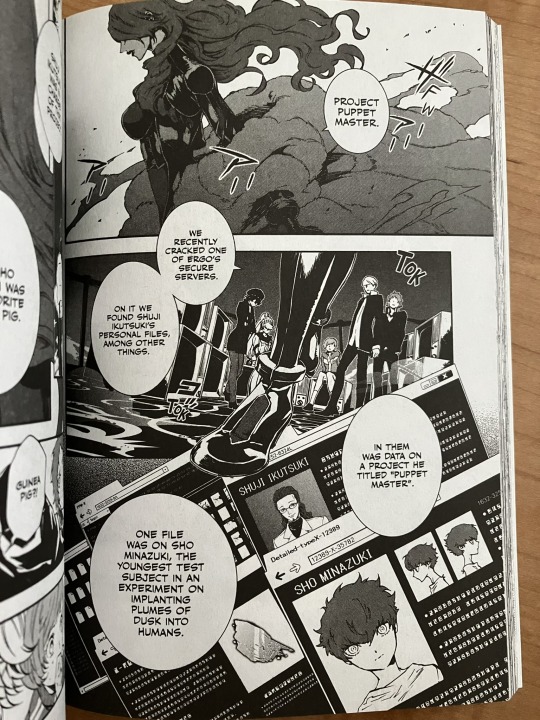
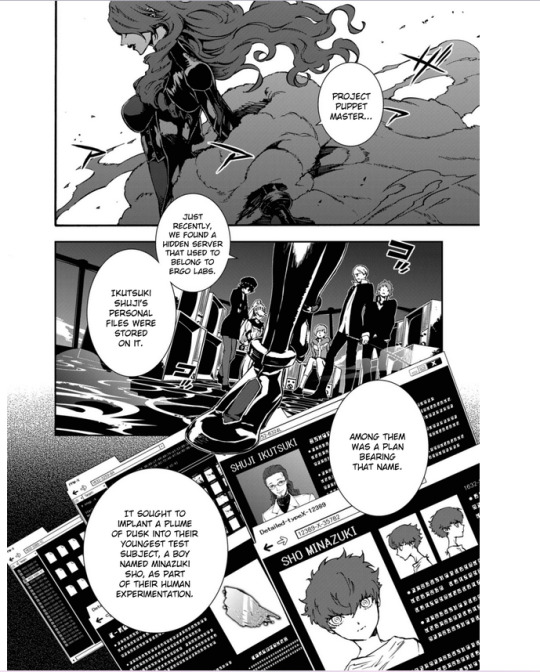
Take this with a huge grain of salt, because I don't know enough Japanese to certify that the official-Eng translation shouldn't be pluralized the way that it is, but, uh... the possibility that there's more than one hidden server and more than just Sho as attempted Plume-implantation subjects??
If the translator had been reliably sticking to the pre-established translations, I would give more weight to the possibility of it being a retcon of how the game presents the information. But since it doesn't seem like the translator is familiar with the original material... I'll personally just add this one onto the “fan-characterization fodder” pile and continue hoping that P3RE might give us more clarity on what exactly the experiments of 1995-1999 entailed, lest my fluency in Japanese reach the point that I can ascertain the answer. TuT
For anyone who wants the Japanese lines in transcribed form:
先日 エルゴ研の隔離サーバから 幾月修司のパーソナルファイルが発見された
その中に”人形使い計画”と名づけられたデータが隠されていた
それは皆月翔という少年が”黄昏の羽根”を使った人体実験の最年少被験者であったことを記したものだ
~~~~~~~~~~~~~~~~~~~~~~~~~~~~~~~~~~~~~~~~~~~~~~~~~~~~~~~~~~~~~~~
Misc. Pics
~~~~~~~~~~~~~~~~~~~~~~~~~~~~~~~~~~~~~~~~~~~~~~~~~~~~~~~~~~~~~~~
(If you wanna see the fan-Eng in higher quality than the screengrabs I used, you can find it on Mangadex [here].)

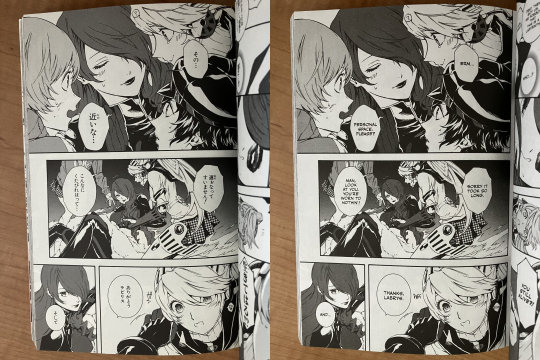
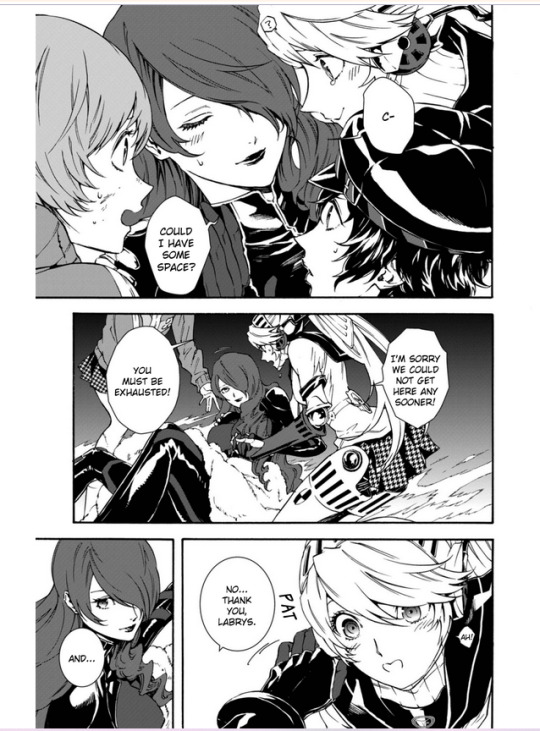

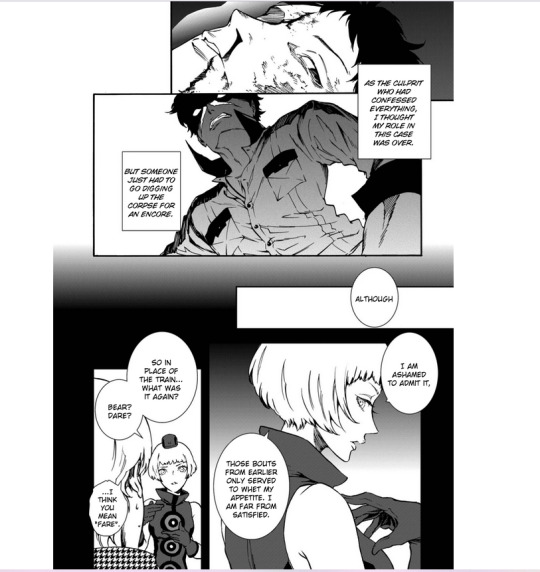
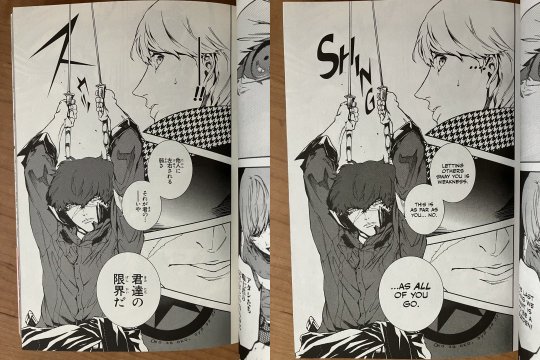

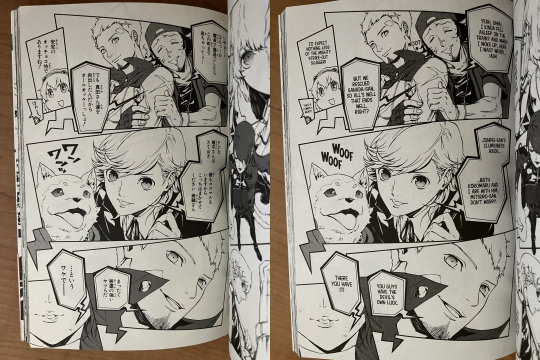
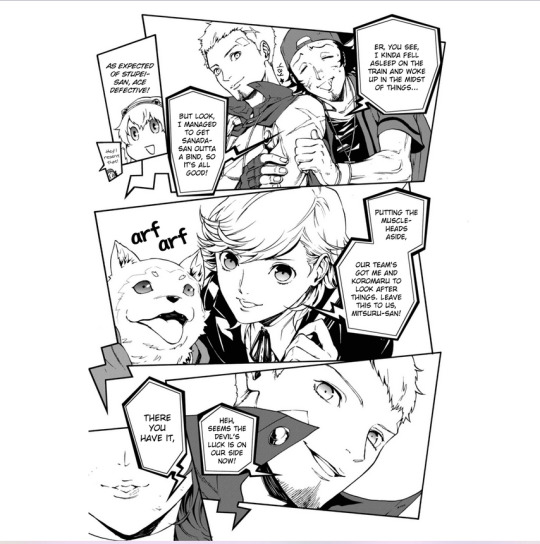
#Sho Minazuki#Yu Narukami#Mitsuru Kirijo#Tohru Adachi#(tagging Mitsuru mostly because of the cover art)#(tagging Adachi because he appears in about half the pages pictured here)#(Sorry everyone; I have no clue how it got wordier than the last review post. I tried to segment it for easier reading at least. >_>;)#(Fun fact: I don't usually describe things as “edgy” -- including Minazuki -- )#(-- but the 'dark' non sequitur dialog was exorbitant enough to defy other applicable descriptors lol.)#(Also if anyone has an enby Sho or Mina headcanon y'all might have fun with this translation lol.)#P4AU/P4U2 manga#Persona 4 Arena Ultimax#P4AU#P4U2#Persona 4 The Ultimax Ultra Suplex Hold#ペルソナ4 ジ・アルティマックス ウルトラス―プレックスホールド
15 notes
·
View notes
Text
Capri’s Guide to Sho Minazuki Content — P4U2/P4AU Art Book
[Link to the masterpost coming eventually!]
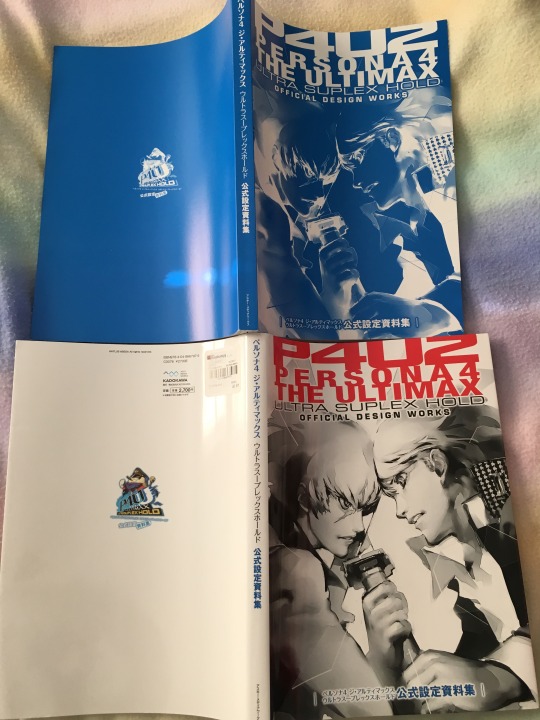
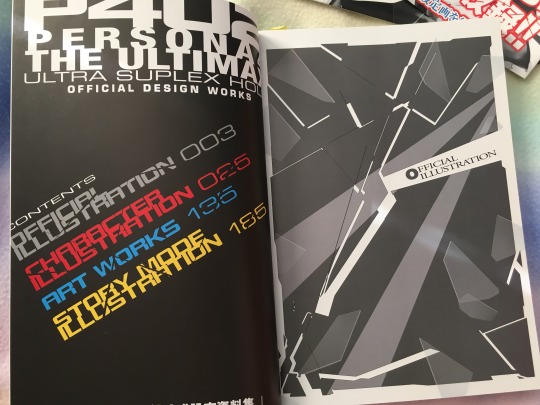
Also known as the “P4U2 (Persona 4 The Ultimax Ultra Suplex Hold) Official Design Works”!
Unlike the P4A/P4U solo art book that came before it, this art book does not have an official English translation, any creator interviews, or any sprite animation frames contained within it, so if you’re looking for any thoughts on the creative process behind Sho, the most you might find is in the ‘story movie’ storyboards section or Tsukiyomi’s prototype concept art. That said! I will break down what Sho-related content is actually included in this book.
Official Illustration
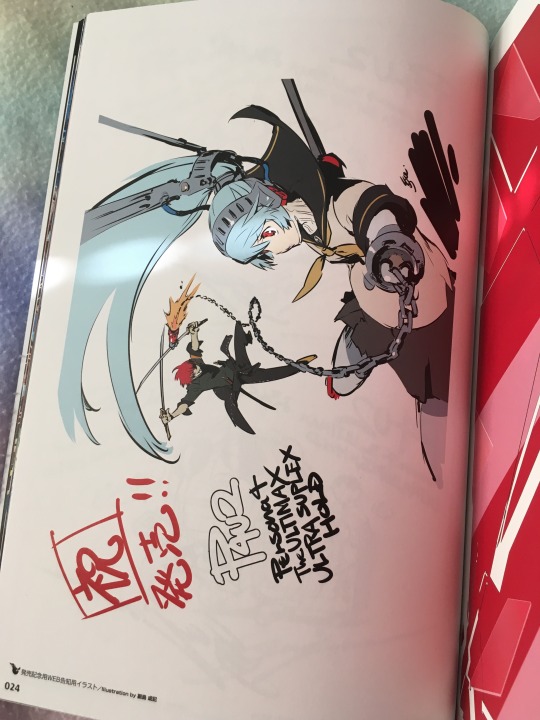
[The background art on the official website] by ドメリカ (maybe “domerica” the company? They appear to at least have worked on this game)
[The normal box art (sans logo)] by アトラス デ ザイン チ ー ム (Atlus Design Team)
[The Shadow version of the box art] by アトラス デ ザイン チ ー ム
[This Sho and Yu] piece by ドメリカ
The cover art piece, albeit in uncropped and textless form, by 副島 成記 (Soejima Shigenori)
[This fighting ring illustration] by アトラス デ ザイン チ ー ム
And the above image by 副島 成記
A thing to note! If the official illustrations are your top priority here, out of the Arena series art books, the cover image art (by Soejima) is only published in this book! It is NOT reprinted in the P4U x P4U2 Super Official Design Works. However, it was also collected in the more recent “Shigenori Soejima & P-Studio Art Unit: Art Works 2″ book alongside a lot of other Arena series illustrations at the very least (if there’s more places, I personally don’t know about them as I’m just a casual working with what I’ve got, not a collector xP). In addition, some of the illustrations here are reprinted in different formatting in the combined art book:
Is printed a little larger in the P4U2 art book than the P4U x P4U2 combined book, though that’s at the expense of the outer edges being somewhat cut-off for the former.
Is printed a little larger in the P4U2 art book than the P4U x P4U2 combined book. In the former, the outer-edges are a bit cut-off, while in the latter, the top and bottom are a bit cut-off instead.
Is printed a little larger in the P4U2 art book than the P4U x P4U2 combined book. In the former, the outer-edges are a bit cut-off, while in the latter, the top and bottom are a bit cut-off instead.
Is printed in a nearly full-page format in the P4U2 book (at the cost of a slight cut-off to the outer edges) versus the 3/4′s page in the combined art book.
Comparing this to the “Shigenori Soejima & P-Studio Art Unit: Art Works 2″ book instead of the P4U x P4U2 one; in this book, it was printed full-page on a single page, oriented landscape-wise instead of portrait-wise. In the Soejima & P-SAU one, it appears to be a two-page print, oriented portrait-style and printed somewhat larger (though the page divide cuts through the illustration as a result). (If you would like to see how it looks in the Soejima & P-SAU book, you can see it showcased a bit in this video here. If the timestamp link fails, it’s at around 3:30 in the video.)
Is printed a little larger in the this book than the combined one, but at the cost of a slight cut-off at the outer edges in the former. The colors are also printed a bit differently, and it has a white border in this book, while it has a black border in the combined art book.
Is printed in a full-page format with a white border in this book and a half-page format with a black border in the combined art book. There is no cut-off in the former.
Character Illustration

In the Character Illustration section, you will find pretty much any character art you can find in the game itself. This includes:
The arcade art, viewable from Gallery Mode in the game, for both Sho and Minazuki (as seen above on the left)
The “glasses/megane” variant of the arcade artwork in a smaller headshot format for both Sho and Minazuki
The official art for Tsukiyomi
The fighter profile/versus art for both Sho and Minazuki
The pre-combat (when you start an arcade run or something and see a character’s fighter tagline) graphics for both Sho and Minazuki (which you can also see a scan from this book of [here] if you’re curious how it looks!)
The Story Mode portraits for both Sho and Minazuki, as well as 6 expressions for each of them in a headshot format. Two of them are duplicated between Sho and Minazuki, and not all of their possible expressions are collected here (for example, Sho’s deliriously angry expression is missing from his set).
A shared ‘profile’ card for them both. It’s basically like the fighter info that shows up beneath a character on the Versus screen (so yes, it’s all “???”s like it is there), but with the addition of a “Weapon” and “Type”(for the weapon) category that does have a bit of non-”???” text. It basically just says that Sho and Minazuki use two katanas, and that I think Sho’s “type” is “body attack”, while Minazuki’s is “standard”, referring to Sho’s lack of Persona (thus using just his ‘body’ to attack) and Minazuki having a Persona like a “standard” fighter in the game?
Minazuki’s Insta-Kill cut-in
And Sho and Minazuki’s shared Awakening cut-in, as well as the glasses/megane version of it (which you can also see a scan from this book of [here] if you’re curious how it looks!)
Everything in this section is reprinted in the combined art book, albeit in different formatting:
The arcade art is actually printed a bit larger in the combined book than the solo one, but only Sho’s is printed in it. Minazuki’s gets relegated to a headshot alongside the glasses renditions of the art, which is zoomed in a bit more and framed by a circle instead of a square.
Is covered above
Tsukiyomi’s art is printed a little smaller in the combined book than the solo one, going from about a half-page to a third-page or a quarter-page
The versus portraits are actually only a smidge smaller in the combined art book than the solo one, and Minazuki’s arm doesn’t get cut off. The torsos for both Sho and Minazuki’s are a bit vertically cropped in the combined artbook however.
The pre-combat graphics are printed significantly smaller in the combined art book than the solo one, going from a 3/4ths page for Sho and a partially-obscured half-page for Minazuki to an equal quarter page for both, albeit Minazuki’s is no longer obscured as a result.
The story portraits go from about a quarter page in the solo book to a eighth-page or so for Sho (and a little smaller for Minazuki) in the combined book. There’s also a third portrait at the same size as Minazuki’s in the combined book showcasing their red-eyes default expression, which is only a headshot in the solo book. Aside from that, they share a pool of 10 total expression headshots in the combined book, some being labeled as exclusive Sho’s, some exclusively Minazuki’s, and some “common” which assumedly are shared by them both. They’re printed slightly bigger than the solo book’s and zoomed in a bit more, and include some of the expressions missing in the solo book (such as Sho’s wilder expressions). It’s still not a complete collection of every possible expression the two could make though; for example, Minazuki’s common ‘forlorn with closed eyes’(or however you’d describe that) isn’t included in the combined book, while it is in the solo book. Neither of them possess the version where Sho’s scar and eyes glow blue in the true ending though.
The “Profile” card is instead a “Personal Data” section in the combined art book, now with added “Star Sign”, “Blood Type”, and “Persona” categories, and also with English category names instead of Japanese (the actual answer text for each category is still in Japanese though). The only one that isn’t just “???”s out of those three is Persona, being answered with “Tsukiyomi (Minazuki)”.
The Insta-Kill cut-in is about the same size in both, although it’s filed under Sho and Minazuki’s section in the combined book instead of the general gallery for Insta-Kills in the solo book. It’s also slightly cropped in the solo book, whereas in the combined book it is not.
The Awakening cut-ins in the combined book are printed a little larger than in the solo one, but they’re also cropped narrower vertically than the solo one’s.
You can find pretty much all of the art in this section on the internet via a simple “Sho Minazuki” search as far as I’m aware, even the full range of Story Mode portrait expressions [here] (albeit you’ll have to do a bit of photo-editing to combine them into whole portraits). So if you just want to see that art outside of the game in general and not possess it specifically in art book form, then that’s very possible for you to do!
Art Works
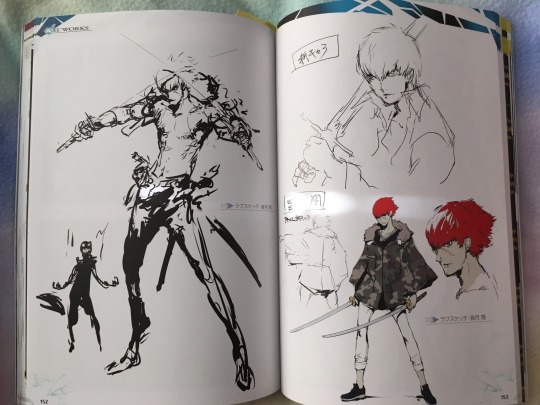
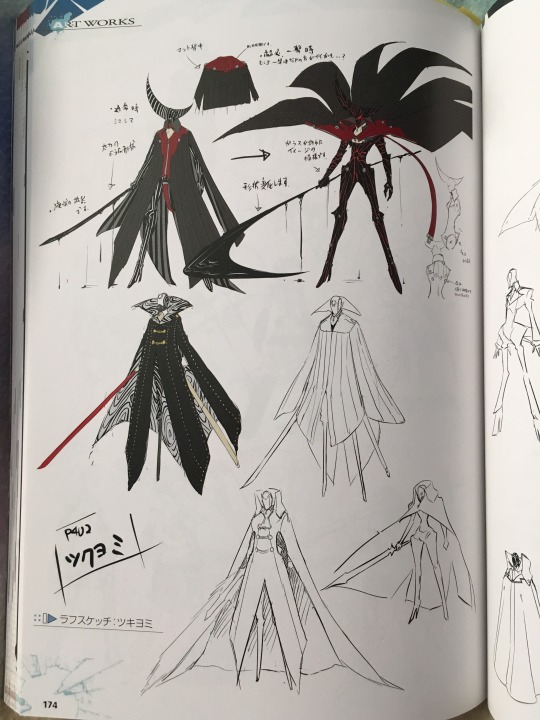

Hanging out in the Art Works section is basically a bunch of concept and technical art! For Sho in this section we’ve got:
Sho’s prototype designs, or as the book calls them, “rough sketch”es. (This also is the source of the camo coat that Sho is illustrated with in the Ultimax manga adaptation, I would guess.) (They’re pictured above, but if you’d like to see them in a clearer digital form, you can see them [here] and [here]!)
Tsukiyomi’s prototype designs (Also as pictured above.)
That’s pretty much it for Sho’s stuff in this section; a final total of 4 pages of content. A big thing to note though! Tsukiyomi’s prototype designs are NOT reprinted in the combined art book. Out of the 3 Arena-series artbooks, this is the only one it’s printed in. (I know, it’s kinda sad that you can’t just get all of Sho’s related concept art in one nice neat place. T-T So... I’m tentatively posting both of Tsuki’s pages here so other people might not have to deal with that issue.)
For the differences in printing for the Sho prototype designs though... The uncolored one with the little blobby dude is printed severely smaller in the combined book, being rendered as about an eighth-page or so as opposed to its full-page rendition in the solo book. The camo coat concept art is printed at about a third of the page in the combined book versus the half-page of the solo book, and the drawing with the two handed sword is roughly a quarter-page in the combined book versus the half page of the solo book.
Story Mode Illustration
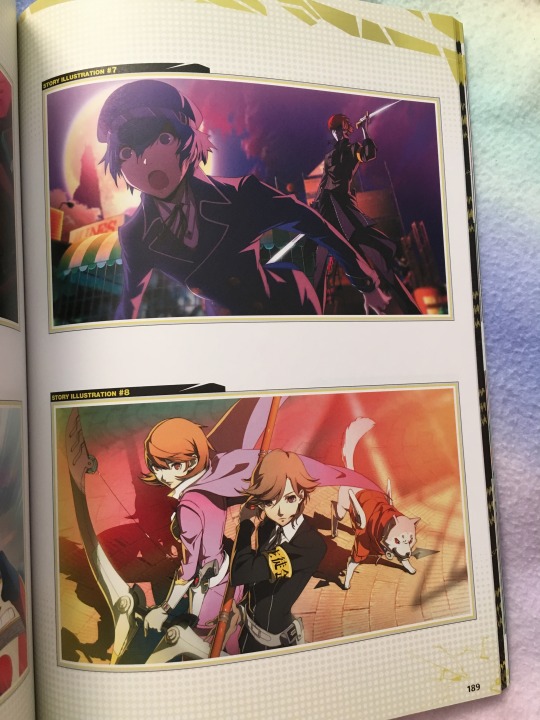
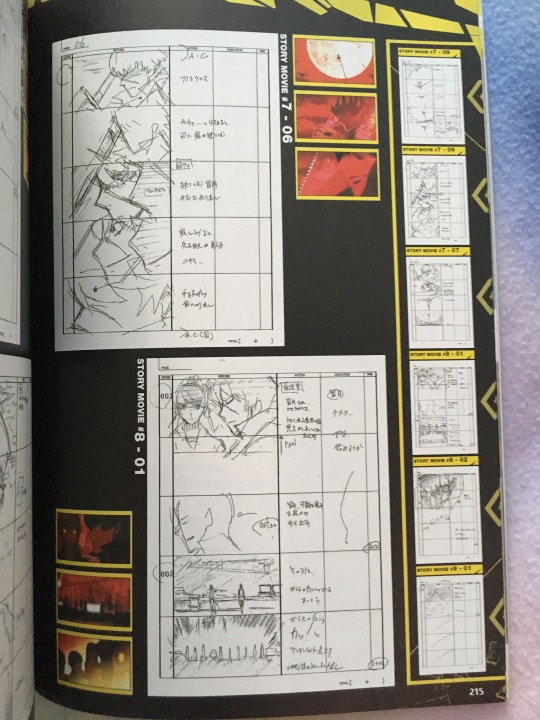
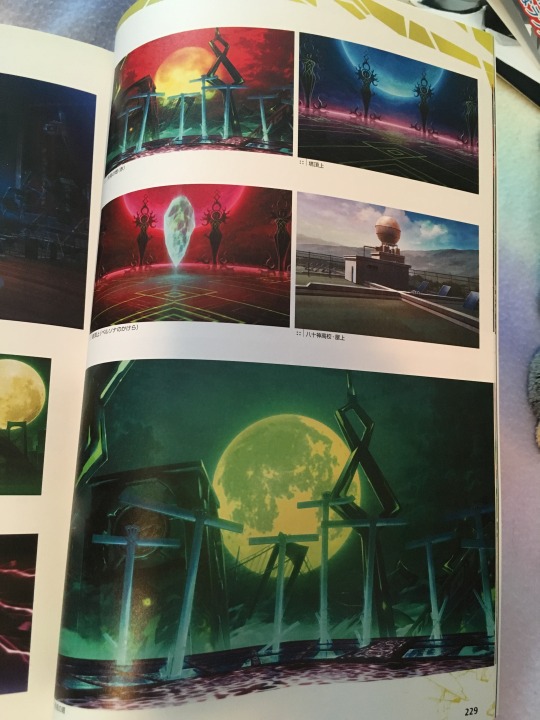
Lastly, we’ve got the section that collects some other pieces of art from the game, such as Story Mode illustrations, Story Mode background art, and then the storyboards for the various animated cutscenes that appear in the game as well. For the last one, it doesn’t really collect many frames from the finished animations in the book (to be precise, it has exactly 3 from each featured storyboard for some comparison between what that specific board covers and the corresponding final product, just not really any printed much bigger than a thumbnail’s size), just the animations’ collections of storyboards.
(Also note: I’m including the background art in this guide due to the fact some of it may hold a strong association with Sho and/or Minazuki for some people, and thus may potentially useful if people are looking for references or collections of them for Sho-related purposes.)
Story Mode Illustration:
(Note: Going by the numbers listed in the book, which should match up with the names they’re given in Gallery Mode in the game, as well as listing their channel numbers from Gallery Mode for reference.)
Story Illustration #7 (Channel 43; Minazuki sneak-attacking Naoto)
Story Illustration #10 (Channel 46; Yu, Chie, and Yosuke meet Minazuki... and Tsukiyomi)
Story Illustration #28 (Channel 64; Mitsuru gets a bleary look at Tsukiyomi)
Story Illustration #37 (Channel 73; Labrys, Yukari, Ken, and Junpei are about to battle Minazuki on the Moon Viewing Platform)
Story Illustrations #38 (Channel 74), #39 (Channel 75), #50 (Ep.Adachi DLC), #52 (Ep.Adachi DLC), and #53 (Ep.Adachi DLC) (or to specify them by details: the picture of General Teddie and Sho/Minazuki at the tower top, Sho facing away from Labrys in the TV Studio, Minazuki/Sho and Adachi on the Moon Viewing Platform just after the fog was summoned, Adachi and Sho facing each other down at the tower top, and Sho pummeling Adachi, respectively) are not included in this book. On top of that, the cut-in image of Minazuki’s sadistic grin on Illustration #37 is also wholly omitted from the book, for whatever reason.
For comparisons in formatting between this book and the P4U x P4U2 one:
#7 is printed at about a third-page size in this book and a large thumbnail size in the combined book, albeit laterally and vertically cropped in this book.
#10 is printed at about a third-page size in this book and.. I honestly don’t know the fraction on this one, but somewhat smaller in the combined book, and is very laterally and vertically cropped in this book.
#28 is printed at about a third-page size in this book and a large thumbnail size in the combined book. ...I can’t really tell if it’s cropped differently between the two due to the overall bleary and dark nature of the image. ^^;
#37 is printed at about a third-page size in this book and a large thumbnail size in the combined book, with Yukari’s arm (specifically) getting cut-off in the combined book but not this one. Beyond that, the Minazuki cut-in portion actually is technically printed in the combined book, but only as a small fractal piece of the background on the Sho and Minazuki profile page (which will be pictured in my P4U x P4U2 artbook post).
#38 is actually printed in the combined art book at least, at about a third-page size.
#39, #50, #52, and #53 are not printed in the combined book either. It is a very sad day that I’ve come to realize this. T^T
So the final verdict is that if you’re looking for Story Mode illustrations of Sho Minazuki, this art book only has less than half of the total ones he’s depicted in from the game.
Movie Story Board:
Opening Movie (Channel 90; the one that plays before you get to the title screen/the one the short version of “Break Out Of...” plays for): all boards (01-29), with boards 04, 05, 08, 11, 14, 18, 20, 24, 26, and 27 being featured. Out of those, Sho appears in boards 04, 23, 24, and 25.
Story Movie #1 (Channel 91; Yu watches the red fog hit Inaba at the start of EpP4): all boards (01-32), though the only one that matters here is board 26, as Sho is set to briefly appear on the TV during the countdown. It is not a featured board.
Story Movie #5 (Channel 95; Sho’s introduction to Yu, Yosuke, and Chie in EpP4): all boards (01-03), with board 02 being featured. Sho appears on all three boards.
Story Movie #7 (Channel 97; the giant backflip.. tower version, not the town version found in some Arcade Mode runs, though only the background really changes if memory serves): all boards (01-07) with boards 04 and 06 being featured. Board 01 is just debris falling, so Sho appears in 02-07.
Story Movie #8 (Channel 98; Minazuki activates the Shadow clones): all boards (01-02), with board 01 being featured. Minazuki only appears in 01, as 02 is a just a shot of the clones ‘coming alive’.
Story Movie #9 (Channel 99; the limo goes off the road): all boards (01-14), with boards 02, 05, 10, and 12 being featured. Sho appears only in board 12.
There appears to be no boards for Story Movies #12 (Channel 104; Kagu-possessed Sho is devoured by Kagu’s new body) or #14 (Channel 106; Sho in the ‘true’ ending when the tower top is all blue) in this book, but they are somewhat collected in the combined artbook! As for the differences, the combined artbook only collects some of the boards at kind of random, but prints them at sizes somewhere between the featured boards and the tinier side-page boards. Alongside that, there’s little captions for each Movie, with two specifically for the Opening Movie, while all of the rest only get one each. The boards it collects for each Movie are:
Opening Movie: 02, 03, 04, 05, 06, 08, 09; 23, 24, 25, 26, and 27
Story Movie #1: board 26 is included
Story Movie #5: 02 & 03
Story Movie #7: 05 & 06
Story Movie #8: 01 & 02
Story Movie #9: board 12 is not included
Story Movie #12: 06 & 07 (06 showcases Sho.. he’s kinda nommed by 07)
Story Movie #14: 02 & 05 (neither of them showcase Sho)
So overall, depending on what you’re looking for out of the animation storyboards, one book might be better over the other, given they both possess some things that the other does not.
Background Illustration:
Pretty much any background art you see in the game is collected here, I believe, though I haven’t comprehensively combed through both the book and the game in their entirety to check the utmost-thoroughly. I have my limits of tedium I’m willing to go to for this stuff, so I apologize. xP
All of the backgrounds art in this book are either formatted as half-page or eighth-page size, with there being one half-page and 4 eighth-pages per full page. ...I’m not going to go through and transcribe-to-translate 65 different Japanese titles for the 65 different backgrounds included in this book so I can properly list the ones likely to be most relevant to Sho, but at least I can verify that I see art from both main routes, their epilogues, the ‘true’ ending of EpP4, and a couple specifically from EpAdachi.
As for the formatting in the combined artbook, the art is significantly smaller, with the biggest being sized around an eighth-page, the middle-size being like an elongated medium-sized thumbnail, and the smallest being like an actual medium-sized thumbnail, scattered around the page much more haphazardly. (The difference will probably be visible when I post the combined art book’s guide. ^^;)
Again, I’m not going as specifically through this part due to lack of concrete names to use, so there may be variances in which version of the background is collected, or some being omitted or gained potentially?
I haven’t ever tried looking up the Story Mode backgrounds on the internet before, so I’m afraid I can’t say how much luck you might be able to have looking for them on the internet versus the books. ^^;
Concluding Notes:
And that’s everything in this book! More or less it’s kind of got the feel of an art gallery in book form to it (which the super-vivid printing of the colors really helps-- it looks really pretty in-person, which the camera kind of picked up), I think, which the combined art book doesn’t quite match, but also lacks a lot of the concept and technical art for Sho that the combined artbook does have.
If you’re looking to get a copy of your own, I recommend checking Mercari or Ebay! I’m not sure if there’s other sites out there that have it or not, since I found my own copies on those, but you can try looking under both the Japanese version of the title (both in Japanese characters and in Latin characters) and the English one in general search engines or various other sites if you wish, or else perhaps sites like Amazon Japan or Rakuten (Japan?) if you’re trying to find a digital copy?
The guide for the P4U x P4U2 Super Official Design Works will come eventually! In the meantime, if you want to get an idea of some of what it possesses in terms of Sho content, I have a post [here] with a few pictures.
Also, if anyone knows something more than I do about anything I wrote here, please feel free to correct me! Nicely, of course, and preferably with an accurate source to cite, but despite being a casual I’d much prefer to have accurate info in these whenever possible.
#Capri's guide to finding Sho Minazuki content#Sho Minazuki#ミナヅキショウ#皆月 翔#Tsukiyomi (Persona)#ツキヨミ (ペルソナ)#P4U2#P4AU#Persona 4 Arena Ultimax#Persona 4 The Ultimax Ultra Suplex Hold#ペルソナ4 ジ・アルティマックス ウルトラス―プレックスホールド#Persona 4 Arena Ultimax artbook#P4U2 Official Design Works#Tsukiyomi prototype designs#ミナヅキ ショウ
18 notes
·
View notes